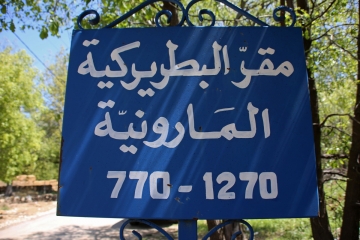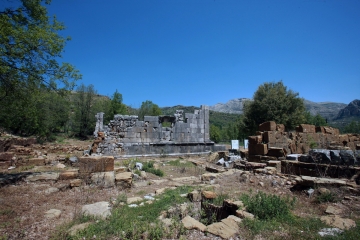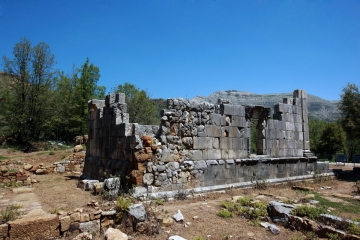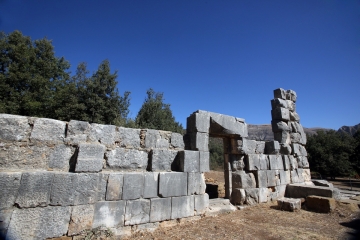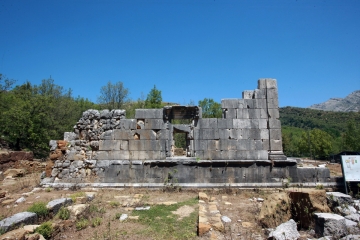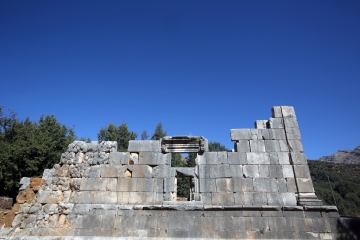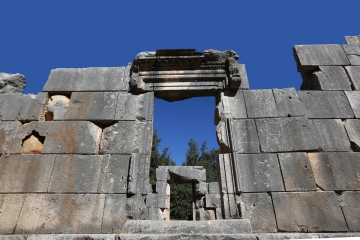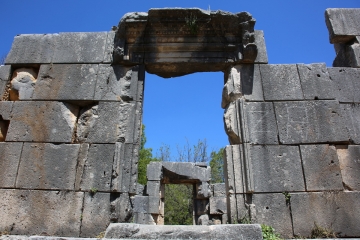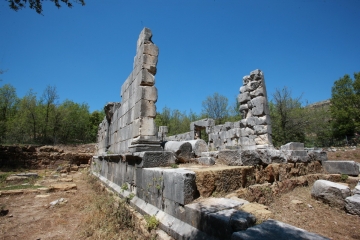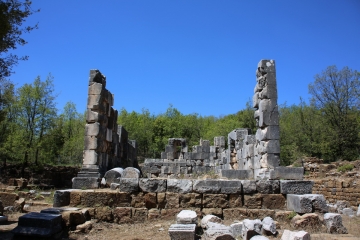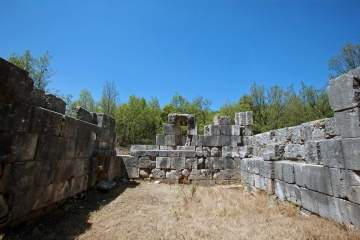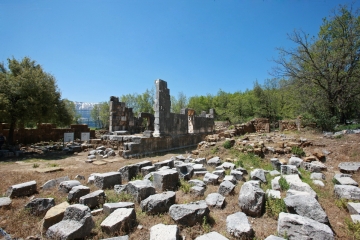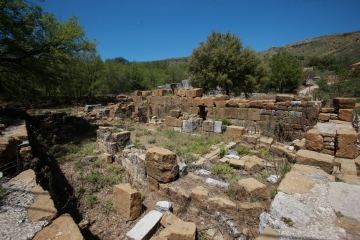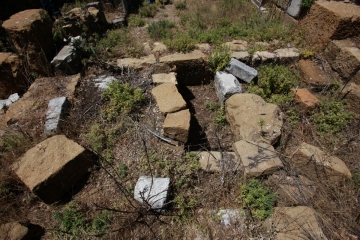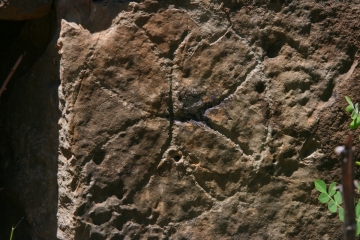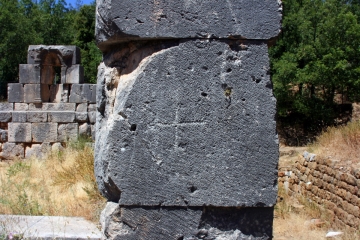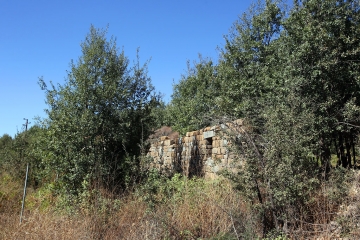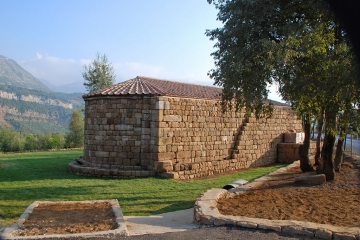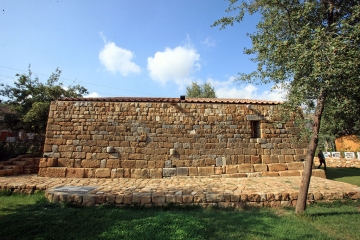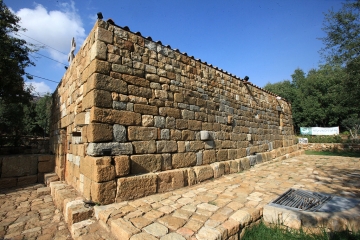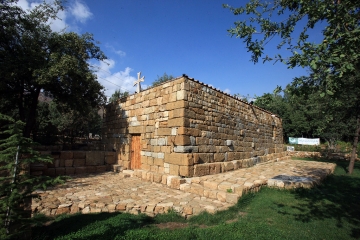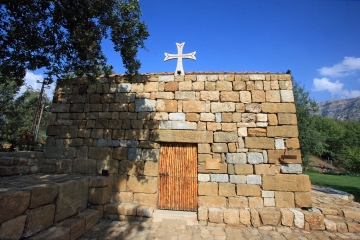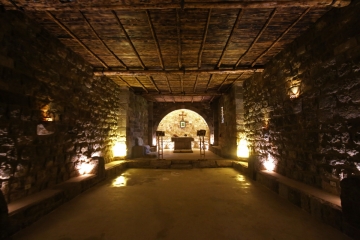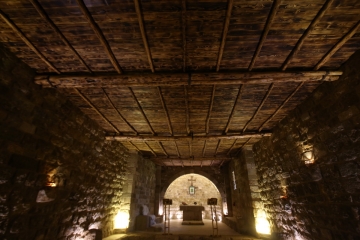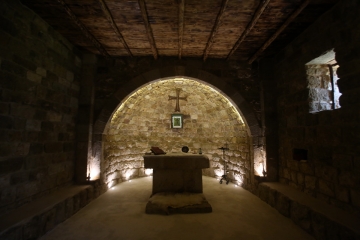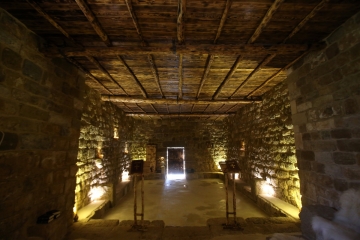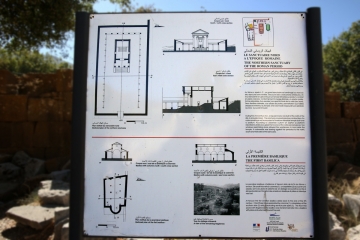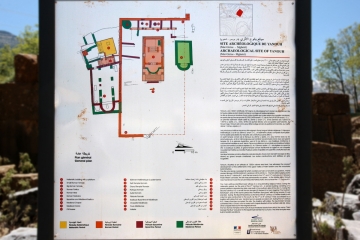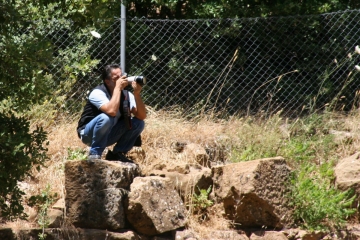سيّدة يانوح
في البَدء لا بُدَّ من مُقدمة تُبَيّن لماذا أصبَحت يانوح مقراً للبطاركة الموارنة، وذلك إستناداً الى نَبذةٍ كَتَبَها السَيّد نبيل يوسف، فَقال بَعدَ أن عَدَّد البطاركة الثلاثة الموارنة الأُوَل الذين سَكنوا دير مار يوحنّا كفرحَي: "البطريرك الماروني الرابع يوحنا مارون الثاني الذي حاول العَودَة الى أنطاكية لإعادة ملء كُرسيّها الشاغر، لكنَّ العَرَب المُسيطرين على تلك النواحي حالوا دون ذلك، فعاد الى جبل لبنان، ولم يَسكُن دير كفَرحَي بل صَعِد الى دير سيّدة يانوح قُرب العاقورة في أعلى بِلاد جبيل وأقام فيه، فإنتقلت البطريركية المارونية الى هُناك
وتابَعَ: "سَبَب انتقال البطريرك الماروني الى يانوح مُرَدُّه الى بُعدها عن المناطق الساحلية المُسيطَر عليها من قِبَل العَرَب، ومن الصَعب جداً على الخيول العربية الصعود الى قِمَم جبل لبنان، على عَكس كفرحَي المُمكن اقتحامها من قِبَل الجيوش الإسلامية".
أما الدويهي فيقول أن يانوح كانَت المركز المُفضَّل عند يوحنا مارون لأنها "كانت من أشرف المجالِس في جِبَة المنيطرة وأهلها كثيرو العِبادة والغيرة".
ونَقَع على تفسيرٍ آخر لاختيار يانوح مركزاً بطريركياً بعد كفرحَي، وهو أنه يَسهُل العبور إليها من ناحية سوريا والبقاع عِبرَ مَمَرَّي العاقورة والمنيطرة، كما يُسَهِل منها اتصال السلطة المارونية، أي البطريركية، بأتباعها وأبنائها في سوريا. وهنا نَجِد ما يُزكّي كلام نبيل يوسف المذكور أعلاه، وهو أن من أسباب اختيارها مقرّاً بطريركياً موقعها الجغرافيّ البعيد عن الساحل لجهة البحر، والآمن وراء سِلسِلة جبال المنيطرة لجهة الشرق، مما يؤمّن لهذا الموقع حماية طبيعية يصعب معها الوصول اليه بسهولة.
لذا انتقل البطاركة الموارنة الى يانوح في جبال لبنان الوَعِرَة المَسالِك والقليلة المَوارِد، وارتضوا العيشة البسيطة، وراحوا يَعمَلون على تركيز المُجتمع الديني، يُحافظون فيه على مُعتقدهم وكيانهم وحُرّيتهم ودَيمومة اتحادهم مع روما .. كما ذَكَر جورج عساكر في كتابه عن "يانوح".
وهكذا يُجمع المؤرِّخون على أن يانوح كانت المَقرَّ الثاني للبطاركة الموارنة بعد كفرحَي، وإن السنة 750م كانت سَنة انتقالهم اليها، وإنهم أقاموا فيها ما يزيد على 500 سنة بصورة شبه متواصلة حتى العام 1277.
لذلك يَنعتون سنة 750 بأنها "جَعَلَت من يانوح المقرَّ الثاني لهم (للبطاركة) بعد مَقَرّهم الأول في دير مار مارون كفرحي، البترون".
نَفهَم من ذلك أن هذا الانتقال كان مُباشراً من كفرحي الى يانوح، ونَحنُ نَعرِف، كما ذكرنا في النبذة عن دير مار يوحنا مارون كفرحي، أن هذا الدير كان المقرَّ الأول للبطاركة الموارنة في لبنان، وأن بانيه كان البطريرك يوحنا مارون الأول لمّا كان مُطراناً على البترون، ثم جَعَلَهُ مَحَلَّ إقامته لمّا أصبح بطريركاً.
يقول الدويهي حرفياً، في "سِلسِلة بطاركة الطائفة المارونية"، ص 13،14،15: "كان في ذلك العَصر جالساً على تَخت مَمْلَكة الروم يوستينيانوس آلاخرم، فأطغاه عدوُّ الخير حتى استمال عقله الى زعم رؤساء الكهنة المُتَمَسكين بِمَشيئة واحدة، فأنشأ الإضطهاد على سركيس صاحب الكُرسيّ الروماني، ولأجل ذلك اضطُرَّ البطريرك يوحنا أن يَنتَقِل من أنطاكية الى دير مار مارون في سورية على نهر العاصي، ومن هناك الى سمار جبيل في البترون".
ولكنَّ هذا القول للدويهي يَتَناقَض مع ما أجمع عليه المؤرِّخون من أن يانوح كانت المقرَّ البطريركيَّ المارونيَّ الثاني بعد كفرحي، ومع ما قاله نبيل يوسف. فإن النَبذَة التي صاغها هذا الأخير تلقي ضوءاً على الأمر بقوله:" عند انتخابه حاول البطريرك مار يوحنا مارون التوجه الى شمال سوريا، لكنه لم يستطع البقاء هناك طويلاً، فعاد الى جبل لبنان حاملاً معه هامة القديس مارون، وجَعَل كُرسيّه في دير كفرحي في وسط منطقة البترون، واستمرَّ في إدارة شؤون رعيَّته من دير كفرحي، وكان في بعض الأوقات يَنتَقِل الى قَلعَة سمار جبيل في منطقة البترون حتى وفاته سنة 707".
أجل، ما زال يوحنا مارون يُجاهِد حتى أكمل سَعيه سنة 707 ودُفن في دير مار مارون في كفرحي، وخَلَفَهُ إبن أخته كوريوس او كيروس أو كورش، ثم عَقَبَهُ في الرئاسة على كُرسيّ أنطاكية جبرائيل على ما وَجِدَ في النِسَخ القديمة، ومن بعد جبرائيل صُيِّر يوحنا الذي تَكَنّى هو أيضاً باسم "مارون" وتَرهَّب في دير مار مارون على نهر العاصي، وقد كَتَب عنه ابن القلاعي قائلاُ:
"وبعده قام مارون تاني
من الدير الربّاني
معلّم شاطر ملفاني
يُدعى يوحنا البارّ
جاء ليانوح بطرك كان،
وسكنه في جبل لبنان"
هذه الشهادة واضِحَة بأن يوحنا مارون الثاني لم ينتقل الى لبنان إلاّ لمّا أصبح بطريركاً: "جاء ليانوح بَطرك كان"، ويؤيّدها ما نقله الخورأسقُف يوسف داغر عن السِمعاني وهو "أن يوحنا مارون الثاني كان من رُهبان دير مار مارون العاصي، ولمّا أقيم بطريركاً قَصَد السَكن في أنطاكية، لكنه لم يَستَطِع اللاقامة فيها لمناوأة العرب له، فجاء وسكن في لبنان، في دير سيّدة يانوح، في جبَّة المنيطرة قُرب العاقورة".
والدويهي نفسه، في ما نُقل عنه من كتاب "تاريخ الأزمنة"، ص 50، يقول:" بَعدَ جبرائيل، البطريرك الثالث في كفرحي، أقيم يوحنا مارون "الثاني" بطريركاً، فحاول العودة الى أنطاكية والإقامة فيها، لكنه لم يَستَطِع ذلك لمناوأة العرب له، فَمَضى الى لبنان وسكن في سيّدة يانوح في جبَّة المنيطرة".
"مَضى الى لبنان" وليس "عاد الى لبنان"، فـ"عودته" الى أنطاكية اذاً كانت من دير مار مارون العاصي في سوريا وليس من لبنان.
وهذا ما لاحَظ عليه مؤلف كتاب "يانوح، مَقَرّ البطاركة الموارنة" جورج عساكر في كتابه هذا، ص 36، فقال:" لم يُقِم البطاركة الموارنة أصلاً في أنطاكية، فكيف يورد الدويهي هذه المُحاولة ليوحنا مارون الثاني؟ ربما لأن مَركَز بطريرك أنطاكية أساساً كان في أنطاكية، فحاول يوحنا مارون العودة الى مركز البَطرَكية لكنه لم يَستطِع بِسَبَب العَرب والبيزنطيين"، أي إن ما دعاه الدويهي "عودة" لم يَكُن عودة للبطاركة الموارنة الى كُرسيّ كانوا فيه ثم نزحوا عنه، لأنهم منذ بطريركهم الأول يوحنا مارون الأول أقاموا في لبنان، بل عَودة الى كُرسيّ بطريركية أنطاكية قبل نشوء الطوائف... الذي كان يَتبَع له مَسيحيو هذه المَنطقة جَميعهم ما عدا التابعين لكُرسيّ أورشليم. ولكنَّ هناك سؤالاً يُطرَح: ذُكر أن يوحنا مارون الثاني كان من رُهبان دير مار مارون العاصي، ولكنَّ هذا الدير قد خَرُبَ منذ عهد يوحنا مارون الأول الذي إنتقل الى لبنان بسبب ذلك، إذ نقرأ في كتاب "مدرسة دير مار يوحنا مارون- كفرحي" للدكتور جان نخول: " وَقَع الاختلاف بين البطريرك يوحنا مارون وبين مَلك القُسطنطينية حول طبيعة السيّد المسيح، مِمَّا اضطُرَّ البطريرك الى التوجه نحو دير القديس مارون الذي ربيَ فيه على نهر العاصي، لكنَّ جَيشَ المَلك تقدَّمَ نحو سوريا سنة 694 وهَدَم دير القديس مارون وَقَتَل المئات من رهبانه، وأمّا البطريرك يوحنا مارون، فَقَد بنى دير مار مارون في كفرحي لكي يكون استمراراً لدير مار مارون الواقع على نهر العاصي والذي تهدَّم". فكيف يكون يوحنا مارون الثاني من رهبان هذا الدير عندما إنتُخب بطريركاً وهو جاء رابعاً بعد ثلاثة بطاركة تَهدَّم الدير في عَهدِ أولهم مِمّا حَمَلَه على المجيء الى لبنان؟، وهل بَعدَ مَقتل المئات من رهبانه ظلَّ فيه آخرون ولم يهجروه وهو الذي لم يعد موجوداً إذ أصبح رُكاماً؟!
هذا ما وُجِبَ أن نَلفُتَ اليه قبل أن ننتقل للحديث عن مجيْ البطاركة الموارنة الى يانوح، مُمَهّدين لذلك بإعطاء صورة عن البلدة وموقعها والآثار التي فيها.
تقع بلدة يانوح، في بلاد جبيل، على سَفح جبل المنيطرة بين قريتَي قرطبا والعاقورة الجبليَّتين، على الضِفَة اليمنى لوادي نهر ابراهيم، وتعلو 1200 متر عن سطح البحر، كما تبعد 94 كلم عن العاصمة بيروت، وبضعة كيلومترات عن بلدة قرطبا
واسمها آراميّ، ويعني "واحة راحةٍ واطمئنان". وهي بلدة أثرية توالت على أرضها الحضارات الفينيقية والرومانية ثم البيزنطية. ومَزار يانوح يَعود للحَقبة الفينيقية، ويَقع في مُنتصف الطريق بين بيبلوس (جبيل)، وهليوبوليس (بعلبك)، وهو الطريق الروماني الشرقي أحَدُهما يتجه نحو أفقا جنوباً، والثاني يذهب شمالاً نحو العاقورة، ويلتقي المَساران عند اليَمّونة ومنها نحو دير الأحمر، وعلى هذا المَسار تبدو آثار لأنصابٍ ومَدافن. ويَذكر الفرنسي إرنست رينان أن مَمَرَّ العاقورة هو مِن أقدم الطُرُق في العالم، ولَعَلَّه كان مَمَرَّ الغُزاة القادمين من الشرق نحو فينيقيا. وفي بداية المَمرّ المُمتدّ من العاقورة الى اليمّونة، في الموقع المعروف باسم "دَرجة سِمعان" نظراً لوجود كنيسة بمحاذاة المنحدر الصخريّ، تَحمِل اسم مار سمعان، تبدو محفورةً في الصخر درجات واسعة. وقد احتفظ هذا الموقع، على غرار صخور نهر الكلب، بآثار مرور الغزاة، وإحدى العبارات اللاتينية المنقوشة على الصخر تُحَدِّد تاريخ إنشاء هذا الطريق في عهد الأمبراطور دوميثيانوس (81-96).
وفي يانوح يبرُز "المَعبد الكبير" الروماني المَبني بِحجرٍ كِلسيٍّ مائل الى اللون الأزرق، مَدخَله لجِهة الشرق، ويحيط به سور من الحجر الرَمليّ.
والمَقَرّ البطريركيّ في يانوح مَوروث من العَهد الوَثنيّ، إذ كان هيكلاً لمعبدٍ فينيقيّ تَحوَّل مع الرومان الى هيكلٍ لآلهتهم، ومع المَسيحيين تَحوَّل الى أول ديرٍ مسيحيٍّ في جبَّة المنيطرة. وهذا "التجمُّع المقدَّس"، كما وَرَد ذِكره في "دفاتر العاصي"، أُطلق عليه اسم "مار جرجس الازرق"، وقد عَمِلَت مديرية الآثار اللبنانية على إظهار بعض مَعالِمِه، وتأكدت من بعض خصائصه الرومانية، والكلام بهذا الصَدَد هو لجورج عَساكِر، الذي يعود فيقول إن "ويبير" الذي زار المكان سنة 1850، ذَكَر أنه كان مَعبَداً يونانياً تَحوَّل في ما بَعد الى كنيسة حَسبَ ما تُظهر هندسة رواقه، بينما يَرى الفرنسيّ إرنست رينان أنه كان مَعبداً فينيقياً للإلَهة عَشتروت، ثم تَحَوَّل من بعد الى كنيسة على اسم مار جرجس الازرق. وكيف ما كان الأمر فقد تمَّ تحويل هذا المعبد الكبير الى كنيسة تَحمِل اسم مار جرجس الأزرق نسبةً الى لون حجارة المبنى. أمّا الدكتور لورتيه فيقول أنه بين قرطبا والعاقورة توجد بقايا معبدٍ صغير، يونانيّ فينيقيّ، يِدعوه الأهالي "رايري" او "موغريري". وكَرَم البستاني، الذي تَرجَم فُصولاً من كتاب لورتيه هذا، يُعلِّق بقوله إن هذا المعبد كان مُخَصَصّاً لديانا إلَهة الصيد عند الرومان وإبنة جوبيتير.
ويقوم المَوقع الأثري عِند أطراف هضبة مُحرّجة كَشَفَت الإنهيارات التي حَدَثَت فيها عن وجود بقايا أثرية لا سيَّما من عَصر البرونز القديم3 (2007-2400 ق.م)، وعَصر الحديد2 (918-539 ق.م). ويبدو أن موقع يانوح هذا قد شُغِل بصورة متواصلة من القرن الثاني ق.م. لغاية القرنين الثاني عشر والثالث عشر الميلاديين... وفقاً للمعالم الظاهرَة للعَيان. وفي القرون الوسطى، وعلى الأقلّ بدءاً من القرن الحادي عشر الميلادي، إشتهرت يانوح كمقرٍّ قديم للبطريركية المارونية. ويَذكر البطريرك اسطفان الدويهي إن دير مار جرجس الازرق أصبح مقرّاً للبطريركية المارونية ابتداءً من العام 939. ويعود تاريخ بناء أول كنيسة في يانوح الى أوآخر القرن الخامس الميلادي، وكانت تَتَألف من ثلاثة أروقة ذات أعمدة، وبيت للعماد في الجهة الجنوبية، وحَنِيَّة ناتئة بشكلٍ نصف دائري، وقد رُصفت أرضيَّتها بالبلاط. وفي ما بعد شَهِدَت الكنيسة تَغيُّراتٍ جَذرية، فَتَحوَّلت الى كنيسة ذات ركائز مبنيَّة وتَوِسَّعت نحو الشرق. ومُحاولة إعادة تكوين المَعبد التي جرت عام 2000 أظهرت وجود واجهة بأربعة أعمدة، في حين أن دراسةً سابقة جرت عام 1938 كانت قد أظهرت واجهةً بعامودين. ويَمتاز مَعبد يانوح بانسجام طرازه، وتَنَاسُق أبعاده، واحتوائه على عدة خاصيّاتٍ "رومانية" وقِلّة المعالم "الشرقية" فيه...
الأبواب-النوافذ على جانبَي المعبد يُمكن مُقارنتها، لجهة استخدامها العَمَليّ، بالنوافذ الجانبية الموجودة في عددٍ من معابد الشرق الأدنى. والى الجنوب من المعبد الكبير تبدو بقايا مبنىً صغير من الحجر الكلسي مائل الى اللون الازرق.. يُدْخَل اليه بواسطة دَرَج، وهو يَتَصِف بِمُميّزات المعابد ويُعْرَف باسم "المعبد الصغير"، مِمّا يُساهم في ادخال موقع يانوح في فئة المواقع الدينية الريفية ذات المَعبَدَين أو أكثر، والتي كانت عَديدة في الجبال اللبنانية وفي الشرق الأدنى إبّان الحقبة الرومانية.
وجنوبيّ المَوقَع تبدو آثار بازيليك ذي ركائز ودعائم، وهي تتألف من ثلاثة أجنحة تنتهي بحنايا، أرضها مرصوفة بالبلاط، وهي تعود الى الحقبة البيزنطية الأولى. أمّا بناء الممرّ المؤدّي الى صَحن الكنيسة فقد يكون عائداً الى القُرون الوسطى.
كذلك يَعود تاريخ بناء الكنيسة الصغيرة الكائنة شمال المَوقع الى القرون الوسطى (القرنين الثاني عشر والثالث عشر)، وهي تَتألف من جِناحٍ واحد، ولها حَنِيَّة بارزة لجِهة الشرق.
ويقول الأستاذ مارون عبود في هذا الصدد في الصفحة 29 من كِتابه "صقر لبنان" ما يأتي:
"فالبطاركة الأوَّلون، من البَطرَك الرابع حتى الحادي والعشرين، كان مَقرُّهم في دير سَيّدة يانوح، وكانوا يعيشون عيشة تَقَشُف ونِسك، لا يعنيهم من شؤون الطائفة أكثر مما يعني أعيانها من تدبير الشؤون المدنية... ثُم انتقل الكرسي البطريركي من يانوح الى مَيفوق وجِوارها حين جَلا عنها الشيخ حُبيش جد الحُبيشيين، حُماة البطريركية في يانوح، وأقام في غزير".
كذلك نُضيف ما قاله الدكتور لويس لورته، عَميد مَعهد الطُب في ليون بفرنسا، في الصفحة 261 من كتابه سوريا اليوم"، الذي تَرجَمه الى العربية الأستاذ كرم البستاني، وهو ما يلي:
""كان في يانوح مَعبد "المْغَيرة" أي المغارة الصغيرة، ويقال أنه كان فيها معبد إلَهة الصيد (ديانا) وحُّوِّل الى دير سيّدة يانوح. وكان لِزَمنٍ كُرسيّاً لبطاركة الموارنة ومَدفون فيه أربعة منهم. وسبب إتخاذهم إيّاه كُرسياً إن تلك المنطقة كانت حِمىً لمشايخ الحُبيشيين حُلفاء الحَماديين، فلجأ اليه البطاركة إتّقاءً للاعتداءات. وهو اليوم شبه خِربة، ولا يزال فيه بقايا أبواب وأعمدة تَدُلُّ على عِتقه".
ولكن ليس المُهِمّ أن نَعرِف تاريخ بناء هذا المَعبَد وأصله قبل المسيحية، بل ما يَهُمُّنا أن نَعرِفَه هو هل كان هو مقرَّ البطاركة الموارنة عندما انتقلوا الى يانوح أم كانت كنيسة سيّدة يانوح هي هذا المقرّ؟
استناداً الى كتاب جورج عساكر الذي نوَّهنا به فإن الصَرِح البطريركيَّ في يانوح كان مؤلفاً من أربعة أقسام هي:
كنيسة مار جرجس الأزرق (وهي حالياً تُعتبر من المعالم الأثرية والسياحية لكونها ما تزال تضُّمُ أجزاء من المعبد الروماني) التي تعود الى العهد البيزنطي، سُمّيَتْ كذلك لأن لون حجارتها يميل الى الزرقة، وفيها صُلبان بقرنين وأربع أذرع تنويهاً بعقيدة الطبيعتين في المسيح، او بالفضيلتين: الكلمة والروح القدس، او بالقدرتين: رئيس الملائكة ميخائيل، وجبرائيل، لمُرافقتهما أنفس الموتى.
كنيسة سيّدة يانوح قد شُيِّدت على اسم العذراء مريم، وهي ذات مداخل وحَنِيَّة نصف دائرية وأروقة، ومزيَّنة بالصُلبان والنقوش. ويقال أنها تعود الى الحقبة الصليبية، وآنذاك ناهز عدد سُكان يانوح 3500 شخص، وبلغ عدد الكنائس فيها 35.
كابيلاّ البطريرك.
المُلحقات، أي مَقَرّ السَكن والإستقبال، وغُرف المؤونة، والأقبية وغيرها.
وعليه فإن الكنيستين معاً: مار جرجس الازرق وسيّدة يانوح.. يشتمل عليهما الصرح البطريركيّ.
يُذكَر أن كنيسة سَيّدة يانوح بَقيت في خراب حتى العام 2016 عندما إتخذ البطريرك الماروني بشارة الراعي قراراً بإعادة ترميمها الذي إنتهى في العام التالي. يُلفت النظر أن إعادة الترميم هذه لم تَشمُل سوى بناء كنيسة صغيرة قياساً الى ما كانت عليه الكنيسة القديمة.
وفي رأي آخر أن كنيسة سيّدة يانوح تَرقى الى الجيل السادس او السابع، أنشأها البطريرك جبرائيل او خليفته يوحنا الثاني المعروف بمارون أيضاً، أمّا هندستها فهي صورة طبق الأصل عن هندسة الكنائس المارونية في سوريا، وكانت كُرسيّاً لبطاركة الموارنة منذ الجيل الثامن حتى سنة 1120م. وقد خاطب الباباوات، ببراءاتهم، المقيمين في سيّدة يانوح والقائمين عليها، وهذا نموذج عمّا جاء في هذه البراءات: "إننا نُثَبِّت كراسي المطارنة والأساقفة... ونأمرهم بالخضوع لكُرسيّ سيّدة يانوح، كنيستك ايها الأخ البطريرك المتولّي رئاستها من الله تعالى، وأن يطيعوا لك ولخلفائك".
البابا اينوشنسيوس الثالث
لاتران، 1215 من التجسُّد الربّاني
ومنذ العام 1999 تتابع بعثة أركيولوجية، تَحتَ إشراف جامعة القديس يوسف، أعمال البحث والتنقيب في الجزء الأعلى من وادي نهر ابراهيم ودراسة موقع يانوح.
ومؤخراً عُثر في يانوح على عددٍ من قطع العملة القديمة التي تعود الى عصورٍ مُختلفة، وعلى العديد من الحليّ والعقود والخواتم والسلاسل والفخّاريات التي لم يُحافَظ عليها مع الأسف، ولو حُفظت لكانت من الدلائل التي تعين على معرفة أوسع لتاريخ البلدة وتاريخ الطائفة المارونية في تلك الناحية على مدى عددٍ من العهود.
امّا بطاركة يانوح فقد أقاموا فيها حوالي خمسماية سنة إمتدَّت ما بين 750م و1277 م. وهذه الحقبة التاريخية تَقَع ضُمن المرحلة المُتوسطة من تاريخ لبنان والمُمتدّة من الفتح الاسلامي سنة 635 الى الفتح العُثماني سنة 1516، وهي من أصعب الفترات التاريخية بالنسبة للكتابة عنها بسبب قلّة المصادر والمراجع. ويضاف الى هذه الصعوبة صُعُوبة أشدّ منها وهي الكتابة عن سِلسِلة البطاركة الموارنة الأنطاكيين في هذه الفترة بالذات، اي منذ نشأة البطريركية المارونية حوالي سنة 685 في القرن السابع وحتى نهاية العصور الوسطى، لأن المؤرخين القدماء والحديثين ما زالوا مُختلفين حول وَضع هذه السِلسِلة إذ لا تُسْعِفُهْم في ذلك مراجع مدوَّنة ثابتة، خصوصاً وأن معظم التاريخ الماروني مُستقى لغاية الآن من مرجعين وحيدين هما زَجَليات إبن القلاعي ومؤلفات البطريرك اسطفان الدويهي. ويرى الأب بولس صفير، حافِظ المَكتَبَة البطريركية سابقاً، بعد بَحثِه وتدقيقه، إن سلاسل الدويهي والسِمعاني والعنيسي هي أقرب الى المستندات التاريخية، مُستنداً الى ان الدويهي استقى معلوماته من مراجع إكيدة وثابتة، حتى أن آباء المَجمَع اللبناني المُنعقد في دير سيّدة اللويزة سنة 1736 ثَبَّتوا مُعظَم سِلسِلة الدويهي وسَلكوا على آثاره في ذِكر أسماء البطاركة الأولين والسنين التي تبوّأوا فيها كُرسيّ انطاكية. ومع كل هذا فَلَم يَتَمَكَن الدويهي من الوصول الى أسماء جميع البطاركة، لأن بعض الكُتب والمخطوطات الشرقية التي لا تزال مَحفوظَة في مكتبتَي الفاتيكان وفلورنسا لم تكن، كما يبدو، في مُتَناول يَدِه، في حين تَوَصَّل السِمعاني والعُنيسي الى هذه الأسماء من المَصدَرَين المَذكورَين، لَكِن فاتَتهُما أيضاً بعض الأسماء التي تَفَرَّدَ الدويهي بذكرها إستناداً الى ما ذكرنا. لذلك فإن الأب صفير وَضَع سِلسِلة تَجمَع ما بين سَلاسِل هؤلاء الثلاثة، فَطَعَّم سِلسِلة الدويهي بما فاته وجاء به السِمعاني والعنيسي، كما طَعَّم سِلسِلتيهما بما تخلوان منه ويتوفر عند الدويهي، فيكون عندنا سِلسِلة هي أقرب ما يكون الى الكمال للبطاركة الذين تولّوا كرسيّ سيّدة يانوح وجعلوها مقرّاً لهم على مدى حقِبة طويلة.
هذه الحَقَبَة يُقَسِمُها مؤلف كتاب "يانوح، مقرّ البطاركة الموارنة" الى مرحلتين:
المرحلة الأولى تمتدّ ما بين 750م و1120م ، والمرحلة الثانية تذهب من 1120م الى 1277م.
لماذا حَدَّدَ المَرحلة الأولى ما بين التاريخين اعلاه؟، لأن أولى سنوات هذه المرحلة جَعَلَت من يانوح المقرّ الثاني للبطاركة الموارنة في لبنان بَعدَ مَقَرِّهم الأول في دير مار يوحنا مارون كفرحي، أما سنة 1120 فلأنها السنة التي ترك فيها البطاركة يانوح لأول مرة الى مقرٍّ جديد هو ميفوق، بعد إقامة طويلة مُتواصِلة في يانوح دامت 370 سنة.
والبطاركة الذين أقاموا في هذا المقرّ خلال هذه المرحلة هم:
يوحنا مارون الثاني، أول بطريرك سَكَن يانوح، ولكن لم يَذكُر المؤرخون مُدَة ترؤس هذا البطريرك لمقام البطريركية ولا سنة وفاته، بل ذكروا أنه "لما قارب الموت جَمَع جميع كهنة جبل لبنان وأقام لهم بطركاً بَدَله يُدعى يوحنا من قرية دملصا من عمل جبيل".
يوحنا الدملصاوي، ترأس بعد يوحنا مارون، وجعله السِمعاني البطريرك السابع والستين بعد مار بطرس والخامس بعد يوحنا مارون الأول، وأنه في عَهدِه التأم مَجمَع نيقية الثاني ضُدّ بِدعة مُحاربي الأيقونات (787) ولم يَتَمَكَّن هذا البطريرك من حضوره.
غريغوريوس الأول، السادس بعد يوحنا مارون
اسطفانوس، السابع بعد يوحنا مارون
مُرقس
أوسابيوس، ذكره الدويهي، وسَمّاه السِمعاني "حَوشب"، وقال إن فوتيوس تغلّب في عهده على إغناطيوس بطريرك القسطنطينية
يوحنا الرابع، ذكره الدويهي في سِلسِلته، وأضاف السِمعاني "أنه في عهده تفاقم الخلاف بين الكنيستين الشرقية والغربية بسبب اغتصاب فوتيوس السدًّة البطريركية ، فعُقد المجمع القسطنطيني في السنة 869، ولم يتمكن بطاركة الشرق من حضوره، فأرسلوا قصّاداً من قِبَلهم
يشوع الأول، الذي استغرب الدويهي، في ما يتعلق به ، وجود بطريرك ماروني باسم يشوع، لأن الموارنة لم يسمّوا يشوع "حرمةً لمن فدانا بموته"، الا أنه عاد فأوضح أن اسمه عيسى، الذي يعني بالسريانية يشوع
داوود، ذكره الدويهي في سِلسِلته وكذلك السِمعاني
غريغوريوس الثاني، وفي عهده كانت بلاد الشام في أسوأ حال بسبب إنحطاط دولة العباسيين
توافيليكتوس، ومعناه "حارس الله"، ذكره الدويهي، ودعاه السِمعاني "حبيب"
يشوع الثاني، عُرِّب اسمه الى عيسى
دوميطيوس، عُرِّبَ "ضوميط"، وفي عهده ظهر المذهب التوحيدي الفاطمي عام 1017
إسحق
يوحنا الخامس ( سِيم في الخمسينات الأُوَل بعد الالف)
سمعان الأول، الذي يُدعى شمعون الأول ( سيم في الخمسينات الأخيرة بعد الألف)
وهؤلاء البطاركة ذكرهم جميع المؤرخين، وأكّدوا انهم أقاموا في جبل لبنان، في كُرسيّ سيّدة يانوح
وبعد هذا البطريرك سمعان، السادس عشر في يانوح، ينتقل السِمعاني والعنيسي الى يوسف الجِرجِسي، بينما يتفرَّد الدويهي بذِكر أربعة بطاركة آخرين هم إرميا ويوحنا وشمعون الثاني وشمعون الثالث، فيبلغ العدد مَعَهُم عشرين، ويقول :" هؤلاء الأربعة هم بلا شك موارنة، وتولّوا الكُرسيّ الأنطاكي بعد مجيء الإفرنج الى بلاد الشام، لأن أخبارهم، والسِجِلات البابوية المُرسَلة اليهم، هي الآن مَصونة عندنا". وقد تَفَرَّد الدويهي بذكرهم "إستناداً الى كتاب قديم جداً يَتَضَمَّن الرِتَب لِخِدمة القِداس، وفي قرب أواخر هذا الكتاب مَكتوبةٌ الخدمة التي يقرأها الشَمّاس عندما يَذكر الكُرسيّ الانطاكي". (الدويهي – السِلسِلة).
اما البطريرك الحادي والعشرون، والذي يُشكّل آخر البطاركة الذين أقاموا في يانوح في هذه المرحلة الأولى، فهو يوسف الجِرجِسي (1110-1120)، ويقول الدويهي، نقلاً عن إبن القِلاعي، أن البَطرَك يوسف الجِرجِسي هذا كان قاطناً في قرية يانوح، وأنه قَبِل التاج والعصا من صاحِب الكُرسيّ الروماني مع دِرع التثبيت.
ويلتقي السِمعاني مع الدويهي "في أن هذا البطريرك كان سنة 1110 مُقيماً في يانوح، وأنه أرسل الى الحبر الأعظم رسالة أعرب فيها عن شديد تعَلُّقِه بالسِدّة الرسولية، فَحَظيَ منه بجوابٍ مؤرَّخ في السنة 1119"، وهذا الجواب "شَهِد الدويهي بأنه كان في أيامه محفوظاً في دير سيّدة قنّوبين".
وكان الجِرجِسي رجلاً عالماً وغيوراً على العقيدة المارونية، "وفي عَهدِه كان الموارنة أحراراً في إدارة شؤونهم الداخلية الروحية والزمنية برئاسة بطريركهم. وقد حافظ الصليبيون على إمتيازات البطريرك الماروني وإحترموه، اذ رأوا فيه رئيساً دينياً وسياسياً لأمّتهِ ومُمَثلاً لوحدتها الوطنية".
كذلك عمل الجِرجِسي على نشر الدين المسيحي في بلاد الشرق، ديناً يُجاهر به أبناؤه ويدقّون الاجراس للدعوة الى الصلاة والقداس الالهي، وهو الذي في عهده إستعمل الموارنة النواقيس بدلاً من آلات الخشب. وقد استمرّ في رئاسة كنيسته الى العام 1120، لأنه "سنة 1119 كان لا يزال بعدُ حيّاً" كما يقول الخورأسقُف يوسف داغر في مؤلفه "بطاركة الموارنة", أما سنة ومكان وفاته فلم يذكرهما الدويهي، بل أورد أن "سنة 1121 كان الجالس على الكُرسيّ بطرس" ، مِمَّا يعني أن الجِرجِسي توفي سنة 1120. وحسب داغر فإن هذا البطريرك توفي سنة 1120 في دير سيّدة يانوح ودُفن فيه. ويُذكر أنه في أيامه جرت الحملات الصليبية الأولى، ولما سَقَطَت بيروت في أيدي الصليبين بنوا فيها كاتدرائية مار يوحنا التي غَدَت بعد سَيطرة المُسلمين على المدينة الجامع العُمريّ الكبير. وبموت الجِرجِسي تنتهي المرحلة الأولى من إقامة البطاركة الموارنة في يانوح، وتكون المدة التي أقاموها فيها ثلاثماية وسبعين سنة مُتواصلة دون انقطاع، وقد بلغ عددهم أثناءها واحداً وعشرين بطريركاً".
بعد هذه الإقامة انتقل البطاركة الى ميفوق حسب جميع المؤرخين، ثم الى لِحفد، ثم الى دير سيّدة هابيل، ثم عادوا بعدها الى يانوح سنة 1200م اي بعد غياب دام ثمانين سنة.
وهنا، أي منذ سنة 1200، تبدأ المرحلة الثانية، وهي تَمتَدّ ما بين سنة 1200م و1277م، أي 77 سنة ولكن مُتقطعة. أما سنة 1277 فكانت السنة التي ترك فيها البطاركة الموارنة يانوح نهائياً ولم يعودوا اليها مطلقاً. فمَن هم بطاركة هذه المرحلة وكم بلغ عددهم؟
البطريرك الثاني والعشرون في يانوح: إرميا العمشيتي (1199-1230)
ثَمَة وجهات نظر مُختلفة حول تاريخ إقامته بطريركاً. ففي إعتقادٍ، أن بدء ولايته كان في العام 1183، وفي إعتقادٍ آخر أنه في العام 1198، والبعض يُضيف سنةً وغيره سنتين على بدء هذه الولاية، فيقول الرأي الأول أنها بدأت في العام 1199، والرأي الثاني أنها كانت سنة 1200، ثم يقفز بدء هذه الولاية عند آخرين الى العام 1209، ولكنَّ الجميع يتَّفقون على أن نهايتها كانت في العام 1230م.
وأصحاب أهَمّ هذه الآراء هم: المُطران يوسف الدبس، وهو يعتبر أن ولاية هذا البطريرك بدأت في العام 1183، أي بعدَ حصول الوفاق بين الفريقين المختلفَين من الموارنة بسنةٍ واحدة أو بِبِضعة أشهر. غير أن الصليبي يَجعَل إقامَتَهُ بطريركاً سنة 1198. والمُطران بطرس ديب يقول، في كتابه بالفرنسية "تاريخ الكنيسة المارونية"، إن تاريخ إقامته بطريركاً هو سنة 1199م.
ويذكر الخورأسقُف يوسف داغر"أن إرميا أإنتُخب بطريركاً في دير سيّدة يانوح سنة 1200"، مُستنداً في ذلك الى "أن البابا اينوشنسيوس الثالث ( 1198-1216) أرسل في عهد العمشيتي مُعتمَداً من قِبَله الى أنحاء المَشرق هو الكاردينال بطرس، قسّيس كنيسة القديس مرشلس، وأنه على يد هذا القاصِد جَدَّد البطريرك والأساقفة يَمين الطاعة للحبرالأعظم، وهذا القاصد عاد الى رومية سنة 1204 كما هو مذكور في سِجِلاّت الفاتيكان"، فالبطريرك إرميا العمشيتي إذاً لم يُنتخَب سنة 1209 كما ورد عند الدويهي وفي المجمع اللبناني. هذا البطريرك وُلِد ونشأ في مَسقَط رأسه عَمشيت، ويُقال أنه من عائلة عُبيد ، ولمّا شبَّ نَزَع الى الحياة النُسكية، فَشاد في المَحل المَعروف بدير مار زخيا، قَلالي وَمَحابس وإستحبس هناك مدةً، ثم ما لبث أن إنتقل الى دير السيّدة في ميفوق. ولكن لم تَطُل مُدَة تَنَسُّكه وإستحباسه، فقد أجمع الرأي على تسقيف هذا الراهب عملاً بعادة إتخاذ أمراء الكنيسة من جماعة الرهبان. فلم يَكَد الكُرسيّ الإنطاكي يخلو من راعيه البَطرَك بطرس اللحفدي او الرابع ( لم تحدد سنة تنصيبه-1199) حتى اجتمع الأساقفة وأعيان الشعب في دير سيّدة إيليج وإنتخبوا إرميا بطركاً في السنة عينها 1199، فانتقل، بعد انتخابه، من ميفوق الى دير سيّدة يانوح. وقد ذهب الى رومه بنفسه وحضر المجمع اللاتراني الذي إنعقد في أيام البابا اينوشنسيوس الثالث ( 1198-1216). وذهابه الى روما كان بناءً على دعوة شخصية وجَّهها البابا اليه بتاريخ 13 نيسان سنة 1213، ولا يزال نص هذه الدعوة محفوظاً في خزانة كتابة أسرار الكُرسيّ الرسولي في السِجِل الخاص بالبابا المذكور. وهو أول بطريرك سافر إلى روما، وكان ذلك في العام 1215، وحَضَر المَجمَع الذي تَقَرَّرَ فيه إيفاد حملة صليبية جديدة لاسترجاع الأراضي المقدسة.
وخلال وجوده في روما يُروى عنه إن المحادثات التي أجراها هناك تناولت الحملة الصليببية المقرَّرة وما يستطيع البطريرك الماروني أن يقدّمه لرجالها من مساعدات، كما جرى درس خطط الدفاع عن الإيمان الكاثوليكي في الشرق. ويروي ابن القلاعي أن هذا البطريرك لمّا كان في روما يُقَدِّس في حضور البابا اينوشنسيوس الثالث ( 1198-1216) وإنتهى الى رفعه القُربان بَقِيَت الشَّيلة مُعَلَّقة في الهواء فوق رأسه، فَذُهل البابا من قداسة هذا البطريرك.. وأمر بِنَقشِ صورة تِذكارية لهذه الآية على جِدار كاتدرائية القديس بطرس.
وقبل عودته من روما وَردَته رسالة من البابا إينوشنسيوس الثالث ( 1198-1216) يَطلب منه فيها: أن يعترف به حبراً على الكنيسة الجامعة ونائباً للسيّد المسيح، وأن يَعتَرِف بأمومة الكنيسة الرومانية له ولكنيسته، ويؤمن إيمانها وبانبثاق الروح القدس من الآب والإبن، ويستدعي الثالوث الأقدس مرةً واحدة عند العماد بالتغطيس، وأن يكون للأساقفة وحدهم حق مَنح سِرّ التَثبيت، وأن يوجِب على كل مؤمن أن يعترف لكاهنه الخاص أقلَّه مرةً واحدة في السنة ويتناول في السنة ثلاث مرات، وأن لا يَستعمِل في القداس أواني زجاجية أو فخّارية أو خشبية بل ذهبية أو فِضِّية.
وقد شَكَّل هذا السَفَر التباساً على مُجمل المؤرخين في أول الأمر، لأنهم استندوا جميعهم الى زجلية إبن القلاعي التي وَرَد فيها أن أمير جبيل، الذي هالته حروب كِسروان، راسل البَطرَك وأحضره اليه، وأقنعه بأن يذهب الى رومة بنفسه ويقدّم الطاعة للبابا ويَستغفِر لشَعبِه ويأتيه بالبَركات. وحقيقة الأمر أن إبن القلاعي خَلَط ما بين البطريرك إرميا العمشيتي (1190-1230) والبطريرك إرميا الدملصاوي (1282-1297) ناسِباً الى الأول سبب سَفَر الثاني، وهذا الإلتباس أزاله الأب طوبيا العنيسي بنشره نَص الدعوة التي وجَّهها البابا اينوشنسيوس الثالث ( 1198-1216) الى العَمشيتي، أما غاية الدعوة الى عقد مَجمع لاتران، فكانت إعداد حملة صليبية لإسترجاع الاراضي المُقدسة وإجراء اصلاحات عامة في الكنيسة.
وعاد إرميا من روما، فَوَصل الى طرابلس في شهر آذار1215، ومنها صَعِدَ الى مَقَرّ البطريركية في يانوح، حيث تَمكَّن، "بفضل العلاقة المُباشرة التي قامت بينه وبين الحبر الأعظم، من ضَبط الكنيسة المارونية في اتحادها مع رومية مدةَ حياته". (عن كمال الصليبي).
وفي السنة التالية، 1216، "استلم البراءة البابوية الموجَّهة اليه من البابا اينوشنسيوس الثالث (1198-1216)، وهي مؤرخة في 2 كانون الآخر سنة 1215، وقد كُتب على أسفلها لجهة اليمين ثلاثة أسطر مفادها: "سنة 1215، من البابا إينوشنسيوس الثالث (1198-1216) الى البَطرَك إرميا". وقد ورد في براءة البابا إينوشنسيوس الثّالث (1198-1216) هذه إلى البطريرك إرميا العمشيتي سنة 1215 ميلاديّة أن دير قزحيّا هو أوّل كُرسيّ أسقفيّ لأساقفة الموارنة .
وأهمّ ما جاء في هذه البراءة عن يانوح هو ذكر كنيسة سيّدة يانوح بصفة أنها مَقَرّ البطريركية، والأمر لكراسي المطارنة والأساقفة بالخضوع لها، وذلك بالعبارة الآتية: "إننا نُثَبِّت كراسي المطارنة والاساقفة بسُلطاننا الرَسوليّ، ونأمُرَهُم بالخُضوع لكُرسيّ سيّدة يانوح، كنيستك أيها الأخ البطريرك المتولّي رئاستها من الله تعالى، وأن يطيعوا لك ولخلفائك". وهناك عِّدة نُصوص تُشير الى رسالة البابا إينوشنت الثالث ( 1198-1216) الى البطريرك إرميا العمشيتي عام 1215، كما هناك ايضاً رسالة من البابا الكسندر الرابع (١٢٥٤-١٢٦١) الى البطريرك شمعون عام 1256، وقد ورد فيهما ذكر المقرّ البطريركي في يانوح.
وأخيراً توفّي البطريرك إرميا العمشيتي سنة 1230 في ميفوق، حسب ما ذكر الدويهي وإبن القلاعي، بعد أن عاش بعد رجوعه من رومة خمسة عشر عاماً، فجاء تاريخ وفاته عند هذا الاخير هكذا:
"ألف ومايتَين وتلاتين عامْ إرميا تْنَيَّح ونامْفي ميفوق قبره أَعْلَمْ"
أما البطريرك يوحنا بطرس الجاجي (1239-1245)، الذي جاء على إثر الشاماتي، فقد انتُخب في دير سيّدة إيليج وأقام فيه لفترة، ومن ثم انتقل الى دير سيّدة يانوح، وعاد من بعد الى إيليج، ليعود ويموت ويُدفَن في يانوح، اما نشرة "سيّدة إيليج" فتقول أنه انتُخب ومات في إيليج.
) البطريرك الثالث والعشرون في يانوح: سمعان أو شمعون (1245 -1277
جاء في المجمع اللبناني أنه قبل البطريرك سمعان او شمعون تولّى الكُرسيّ البطريركي يوحنا الجاجي، وأنه قد أقام في يانوح، غير أن الكتابة السريانية التي وردت في إنجيل رابولا (الذي سَيَرِد الحديثُ عنه لاحقاً في سِياق التَحدث عن البطريرك يوحنا (1151-1154) في أثناء الكلام عن دير مار الياس لحفد) حَسَمَت الموضوع مُثبتةً إقامته في ميفوق. لذلك لن نَذكره مع البطاركة الذين أقاموا في يانوح والبالغ عددهم ثلاثة وعشرين بطريركاً، بل سَنُتابع، بعد إرميا، مع البطريرك سمعان أو شمعون.
يذكر الدويهي " أن شمعون ذكره الياس، من معاد، قائلاً في خاتمة الحاش الذي نسخه بخط إسطرنجلي سنة 1245 م: " كان النجاز منه (من الحاش) في أيام ساداتنا البَطرَك شمعون صاحب الكُرسيّ المَمدوح مدينة الله أنطاكية، والمُطران سِمعان بجبل لبنان، سنة 1556 لليونان، وبعد ذلك بعشر سنوات ورده الى دير يانوح مكتوب من البابا اسكندر الرابع (١٢٥٤-١٢٦١) شبه ذلك الذي أرسله البابا اينوشنسيوس الثالث (1198-1216) الى البطريرك إرميا.
وقد عَرِفَت المنطقة في عهد هذا البطريرك حالة من الجور والظُلم والفُقر، وبعد تولّيه بوقتٍ قليل، اي سنة 1246 م، وعلى أثر انعقاد مجمع ليون الأول، كلَّف البابا إينوشنسيوس الرابع (١٢٤٣-1254) الأخ لورنسيوس من قِبَله لزيارة الكنائس الشرقية بخصوص بعض القضايا، فحمل هذا القاصد الى رؤساء هذه الكنائس الرسالة المؤرخة في 9 آب 1246 والتي خصَّ البطريرك سمعان بنسخة منها.. سِلَّمَه إياها القاصد المذكور.
وقد روى مؤرخون كثيرون، ومنهم مؤرخو الإفرنج، أنه " في 14 ايار سنة 1250، لما بلغ القديس لويس التاسع ملك فرنسا الى عكا، أرسل اليه نصارى لبنان الموارنة مالاً ورجالاً، ونزل كثير منهم من الجبال لمشاهدة ملك فرنسا كما نزل أجدادهم من قبل لمُشاهدة الصليبيين الأولين.
فالموارنة يُسَمّون الملك لويس "سيف العالم، وإبن الشريعة والإنجيل". وقد بَعَث إليه أمير لبنان، تحت إمرة إبنه، 25 ألفاً من الجنود يحملون اليه المؤن والهدايا، فوجَّه القديس لويس الى الموارنة تلك الرسالة الشهيرة:
لويس ملك فرنسا
الى أمير الموارنة بجبل لبنان، والى البطريرك وأساقفة الطائفة المذكورة
"إن قلبنا امتلأ فرحاً لما رأينا ولدكم سِمعان قد أتى مع 25 ألفاً حاملاً الينا شهادة حاسَّتكم الحبّية ومقدِّماً لنا الهدايا الفاخرة. وبالحقيقة أن مَحَبَّتنا الخالصة التي ابتدأنا أن نَستَشعِرُها نحو أمة الموارنة أيامَ حلولنا في قبرس حيث هم مقيمون.. قد تضاعفت اليوم بزيادة. ونحن موقنون بأن الأمة التي قامت تحت اسم القديس مارون هي قِسمٌ من الأمة الفرنسية، لأن محبتها للفرنسيين تُشبه مَحَبَة الفرنسيين بعضهم للبعض. وعليه فيجب من قبيل العَدل أن تَتَمتَّعوا أنتم وجميع الموارنة بنفس الحماية التي يتمتَّع بها الفرنسيون من جانبنا، وإن تُقبَلوا في الوظائف كما هم يُقْبَلون. ولذلك فإننا نَستَحثك، أيها الامير الرفيع الشأن، على أن تسعى كل السعي في ما يعود على أهل لبنان بالسعادة، وأن تُعنى باقامة أشراف من أكثر الناس أهليةً لديك كما هو جارٍ في فرنسة. وأنتم أيها السيّد البطريرك والسادات الأساقفة وجمهور الإكليروس وعامة الشعب الماروني وأميركم العظيم، إننا رأينا بكامل السرور تَعَلُّقكم الثابت بالدين الكاثوليكي واحترامكم لرئيس الكنيسة خليفة القديس بطرس برومة، فَنَحُثكم على المُحافظة على هذا الاحترام، وأن تبقوا دائماً غير مُتزعزعين بهذا الإيمان.
أمّا نحن، وجميع مَن يخلفوننا على عرش فرنسة، فَنَعِد بأن نُوليكم أنتم وجميع شَعبِكُم حمايتنا الخاصة كما نوليها للفرنسيين بعينهم، ونسعى في كل وقت في ما يكون آيلاً لسعادتكم".
وفي سنة 1255م كاتب البَطرَك سمعان البابا ألكسندر الرابع (١٢٥٤-١٢٦١) مباركاً له في ارتقائه للرئاسة المُقدَّسة، وحلف له بالخضوع والطاعة، وسأله أن يرسل له دِرع إكتمال الرئاسة. فأرسل له الدِرع المُقدَّس ومكتوباً جميلاً (اي البراءة)"، وهي تُشبِه البراءة الموجَهَة الى البَطريرك إرميا وبالقياس ذاته ايضاً، وقد عُلِّق على أسفلها بثلاثة أسطر ما مفاده:
سنة 1255 ربّانية
من بابا اسكندر الرابع
الى بطرك الموارنة
لم يذكر المؤرخون هذا البطريرك، غير أن الدويهي ذكر "أنه سنة 1277 كان لا يزال بعدُ حياً، إلا إن هذا التحديد ما وجدنا له خَبراً ولا عَلِمنا مَن خَلَفَهُ".
وبانتهاء العام 1277 تنتهي المرحلة الثانية من إقامة البطاركة في يانوح، فمع البطريرك سمعان المذكور تركها البطاركة الموارنة للمرة الاخيرة .
فيكون البطاركة قد أقاموا في يانوح، في المرحلتين، ما مجموعه أربعماية واثنتان وثلاثون سنة، منها ثلاثمائة وسبعون سنة متواصلة دون إنقطاع.
ولكنَّ هذا الثبات للبطاركة الموارنة في مقرّ ٍ واحد ما لبث أن تغيَّر مع مجيء الصليبيين الى الشرق وسيطرتهم على البلاد، فنرى البطاركة يتركون يانوح لأول مرة عام 1120 م، مع الجرجسي، الى ميفوق، وبعدها الى أديار اخرى عديدة في بلاد جبيل كالكَفر ولِحفِد وهابيل، ثم يعودون اليها سنة 1200م مع إرميا العمشيتي الذي عاد وتركها هو ايضاً سنة 1230 الى ميفوق، ثم يعودون اليها من جديد مع البطريرك سمعان سنة 1245 م ليتركوها نهائياً سنة 1277 م.
أسباب هذه التنقلات غير واضحة، ففي حين يَرُدُّها المَجمع اللبناني الى توافق أحوال الزمان والمكان، يعزوها الأب صفير "الى الحروب والفتن". وأغلب الظن أن الصليبيين كانوا وراء انتقال البطاركة من يانوح .
وربما أغفل المؤرخون الموارنة ذِكر أسباب هذا الانتقال لأن هذه الاسباب تتعلق بالصليبيين، خصوصاً وإن أول انتقال حَصَل في عهد الجرجسي.. البطريرك الماروني في عهدهم.
ولأن التواريخ لم تورِد لنا ذِكر أيِّ خلافٍ بين الموارنة قبل قدوم هؤلاء، أي خلال الثلاثماية وسبعين سنة التي سبقتهم، فإننا نتساءل: ماذا كإن مَوقف الموارنة من الصليبيين؟
المعروف إن الموارنة مشوا أمام الصليبيين منذ الساعة الأولى لدخولهم الشَرق وكانوا فَرحين مَسرورين لِمَجيئهم. فقد أورد مؤرخهم "أن بأرض فينيقيا، بين قِمَم لبنان ومدينة جبيل، أناساً سِريان بلغ عددهم حوالي الأربعين ألفاً.. على قدرٍ كبير من الشجاعة والبراعة في الحرب والفروسية، وقد كانوا عوناً كبيراً جداً لجيوشنا في معاركهم ضد الاعداء".
هؤلاء السريان الموارنة "كان لهم عند الصليبيين المقام الأول بين جميع الطوائف المسيحية الأخرى، واتحادهم الدائم بالكنيسة الكاثوليكية، أدّى بِهم الى التقرب أكثر فأكثر من الصليبيين الذين اعتبرهم الموارنة إخوةً لهم في الدين، والعلاقة الوثيقة بينهما وَصَلت الى حدود التلاحُم والتآخي، وكان روّادها البطاركة والاساقفة والشعب الماروني الذي كان يُقيم في المناطق التابعة لسنيورية جبيل وعلى رأسهم يوسف الجِرجِسي المقيم في يانوح بالذات.
غير أن هذا الموقف الماروني الإيجابي من الصليبيين، كما يرى بعض المؤرخين بالإستناد الى ما ورد في زجلية ابن القلاعي، لم يَكُن موقف جميع الموارنة، إذ كان لفريقٍ آخر منهم،"وهم أبناء العشائر في جبَّة بشرّي، وجرود البترون وجبيل"، موقف مُتَحَفِظ وصل بين فترةٍ وأخرى الى تحدّي الإفرنج والثورة عليهم، وذلك لأسباب عديدة أهمُّها:
لأن بعض تَسَلُّط الصليبيين الذين حاولوا ابتلاع فرادة الموارنة ومُميّزاتهم ككنيسة ومجتمع
الموارنة لم يأنسوا للتدابير الإدارية التي استحدثها أصحاب قومسية طرابلس لضبط أمور الجبل عن طريق التنظيم الإقطاعي.
استكبار الفرنج على المسيحيين من أبناء البلاد.
أسلوب المُعاملة العنيفة الذي استعمله الصليبيون ضُدَ المسلمين، في حين أن قسماً من الموارنة كان يميل الى الأسلوب السلميّ.
أمام هذين الموقفين يُطرح السؤال من جديد: ما هي حقيقة الخِلاف بين الموارنة أنفسهم من جِهة، وبينهم وبين الصليبيين من جهةٍ ثانية؟
يبدو أن خلافاً مُستحكماً وَقَع بين الموارنة في تلك الفترة (الصليبية) وإن حاول بعض المؤرخين تجاوزه او نَفيه بأساليب مُتعددة. فقد بَرَزَ هذا الخلاف في عَهد الجِرجِسي.. عندما أظهر مَيلاً كبيراً الى "الليتنة" في الطقوس والممارسات الدينية. فقد يكون هذا المَيل الى الليتنة قد قابله ميلٌ آخر ضِدَه.. شجَّعته التعاليم التي جاء يبثها في جبّة يانوح وجبَّة بشرّي وجرود البترون المُطران توما الكفرطابي سنة 1104، الذي يظهر أن مُعتَقَدَه كان مُخالفاً لمُعتقد الصليبيين والموارنة وبطريركهم... فهذا المَيل أصبح له مؤيدوه.. الذين راحوا يُعارِضون البطريرك. ويبدو أن أصحابه أصبحوا يُشكّلون فريقاً قويّاً تَوَصَّل الى شَقّ المُلك الى إثنين، حتى أن الفريق المُنشق تساهل في مرور بزواش التركي أمير حلب عبر مَمَرّات لبنان الجبلية وهو في طريقه من بعلبك الى طرابلس لقتل قومس طرابلس الصليبي، مِمّا جعل ردّة فعل إبنه ريموند قاسية تجاه هؤلاء الموارنة، إذ هاجمهم في جِبَّة بشرّي وأعدم الكثير من نسائهم وأطفالهم سنة 1137م.
وبعد الكفرطابي يَذكُر الدبس، نقلاً عن لكويان ، أنه قام ابن شعبان "وأخذ يَكتُب ويُعَلِّم الأحداث ويَبذُر الضِلال بين الموا رنة. وقام بعده إبن حسّان وأطغى أهل كفرياشيت. وكذلك إجتمع رؤساء الموارنة وأعيانهم وكثيرون من الشعب وجزموا على أن ينفصلوا عن شركة البطريرك، فلم يعودوا يؤدون له الطاعة ولا يقبلونه في البلاد، بل أنهم حَطّوه عن مقامه وانتخبوا بطريركاُ آخر، فَحنق لذلك أصحاب البطريرك المعزول وقتلوا البطريرك الجديد. فتعاظم الخلاف والشغب بينهم، فتدارك أمرهم ايميكيس البطريرك الإنطاكي على اللاتين، وسكّن روعهم وأخمد جذوة غضبهم، وردّ المغويّين عن غيِّهم، فاتفقوا جميعاً على إنتخاب بطريرك صحيح المعتقد".
ويذكر الأب بطرس ضو "أن هذه الأحداث جاءت نتيجة لانتقام الصليبيين بفظاظة من موارنة جِبّة بشرّي، وإنها كانت مقدمة خطيرة انفجرت بين شطر كبير من الموارنة والفرنج، وبلغت ذروتها الدينية بعِصيان هذا الشطر على روما وعلى رأسه البطريرك لوقا البنهراني من جبة بشري، وبلغت ذروتها العسكرية بأخذ نور الدين المملوكي لجبة المنيطرة.. وعلى الأرجح بتسهيل ومعاونة من الشطر الماروني المذكور".
هذه البلبلة، وهذه الفتن، وَقَعَت في القرن الثاني عشر، وَظَهَرَت آثارها واضحةً في التاريخ الماروني حيث نجد فراغاً بلغ حوالي نصف قرن في تسلسل عدد وأسماء البطاركة الموارنة بين عامَي 1150 و1200، اي ما بين يوحنا اللحفدي وإرميا العمشيتي الذي عاد مجدّداً الى يانوح سنة 1200، وهي مقرّ البطريركية الشرعي، واستطاع ضبط امور الموارنة وضبط إتحادهم مع رومية مدّةَ حياته.
يقول الدويهي في حديثه عن البطريرك يوحنا اللِحفدي الذي كان في هابيل سنة 1151: "إننا ما اهتدينا الى معرفة البطاركة الذين أقاموا في هابيل حتى نُثْبِت اسماءهم، أما إرميا فإنه جَلَس بعد هؤلاء سنة 1209 في يانوح". هذا بينما نرى الخورأسقُف يوسف داغر يَجعَل "بين يوحنا اللِحفدي سنة 1151 والعَمشيتي سنة 1209 بطريركاً واحداً باسم بطرس". أما المجمع اللبناني فينتقل مباشرةً بعد اللِحفدي الى العمشيتي. والسِمعاني يذكر أنه أقام في هابيل. وبعد اللحفدي، سنة 1151، جلس بطرس، وبطرس، وبطرس الآخر ولوقا المُسمّى بطرس، وهذا ما يذكُرَه المُطران ديب أيضاً.
أما الدبس، نقلاً عن لكويان ، فيجعل "يوحنا اللحفدي البطريرك الثامن والعشرين"، ويضع 29، 30، 31 أرقاماً بيضاء لأنه لم يهتدِ الى أسماء ثلاثة بطاركة، ثم يذكر لوقا ايضاً قبل إرميا.
قلنا أن البطريرك إرميا العمشيتي إستطاع أن يضبط الكنيسة المارونية من جديد، ولكن يبدو أنه ما أن توفي هذا البطريرك حتى عاد الإنشقاق مُجَدداً.. بالغاً ذروته سنة 1282، تاريخ ترؤس الدملصاوي على الكنيسة المارونية، غير أن هذا البطريرك وُفِّق ايضاُ خلال ولايته الى القضاء على هذا الإنشقاق وتوحيد الصفوف قبل وفاته سنة 1297.
بعد هذا العرض نسأل: ماذا كان تأثير هذه الأحداث على إنتقال البطاركة من يانوح؟
إن يانوح، بإستمرارها مقرّاً بطريركياً طوال ثلاثماية وسبعين سنةً متواصلة دون إنقطاع، قد اكتسبت شهرةً كبيرة، إذ غدت تُمثّل مركز السلطة الدينية العليا والشرعية للموارنة؛ لهذا حاول الفريق المُنشَقّ الضَغط على هذا المركز للتأثير، وربما للسَيطرة عليه، ليَفقُد البطاركة دورهم ويُصادَر منهم القرار.
ويَظهُر إن قوة هذا الفريق المُنشقّ قد بَلَغَت مَبلغاً مُهمّاً، وكذلك عَدده، وإلاّ ما كان استطاع السَيطرة على جميع المَناطق الجَبلية العالية والتأثير على البَطرَكية مع كُل مُساندة الصليبيين لها. ولوجود يانوح كَمركز أعلى للسُلطة في الجِهة الجنوبية لهذه الجِبال والجُرود (أي بشرّي والبترون وجبيل)، وكي لا تَسقط في أيدي المُنشقَّين فيُسَيطروا على قرار البطريركية فيها، كان البطاركة في أيام الفتن والقلاقل يُحيّدون رَمزَ هذه الُسلطة عن تلك الجبال .. وينزلون به الى بلاد جبيل الوسطى كميفوق ولِحفد وهابيل وغيرها، جاعلين من إديار هذه القرى مَقرّاً مؤقتاً لهم، وبعد أن يضبطوا الأمور ويقضوا على الخِلافات يعودون الى مركزهم الأصيل في يانوح. ولكنَّ يانوح لَقِيَت نهايتها تماماً بعد معارك وحروبٍ يطول شَرحها.. لأن الموارنة، في نظر المماليك، كانوا نجدةً للإفرنج، لذا أُحرقت البلدة ونُهبت بيوتها وصارت قاعاً صفصفاً، ولا تزال آثار الحريق باديةً على معظم كنائسها وبيوتها وكلّ حجرٍ فيها إلى اليوم.
Our Lady of Yanouh
We should start by explaining why Yanouh became the headquarters of the Maronite Patriarchs, and we base ourselves on a brief written by Mr. Nabil Youssef, who said, after enumerating the first three Maronite Patriarchs who inhabited the monastery of St. John Kfarhi: “The Fourth Maronite Patriarch, Youhanna Maroun II, tried to return to Antioch to fill its vacant seat, but the Arabs controlling those areas prevented that, so he returned to Mount Lebanon, and did not live in the monastery of Kfarhi, but rather went to the monastery of Our Lady of Yanouh near Aqoura in the upper area of Byblos and resided there; that is how the Maronite Patriarchate moved there.”
He continued: "The reason behind the move of the Maronite Patriarch to Yanouh is because it is far from the coastal areas controlled by the Arabs, and it is very difficult for Arab horses to climb to the summits of Mount Lebanon, unlike Kfarhi, which can be stormed by Islamic armies."
As for Doueihy, he says that Yanouh was the preferred headquarters for Youhanna Maroun II, because "it was one of the most honorable locations in Jubbat al-Munaytra, and its people were pious and zealous."
We find another explanation for choosing Yanouh as a patriarchal center after Kfarhi, which is that it is easy easily accessible from Syria and the Bekaa through the al-Aqoura and al-Munaytra corridors. This supports the theory of Nabil Youssef, which is that one of the reasons for choosing this patriarchal seat is its geographical location far from the coast towards the sea, and the safety behind the al-Munaytra mountain range to the east, which provides this site with natural protection and makes it hard to reach.
Therefore, the Maronite Patriarchs moved to Yanouh in the mountains of Lebanon, an area of rugged roads and few resources, and they were satisfied with leading a simple life. They began to direct their focus on the religious community, preserving their beliefs, entity, freedom, and the permanence of their union with Rome, as George Asaker mentioned in his book on "Yanouh".
Thus, historians unanimously agree that Yanouh was the second headquarters of the Maronite patriarchs after Kfarhi, and that the year 750 AD was the year they moved there, and that they resided there almost continuously for over 500 years until 1277.
This indicates that Yanouh succeeded Kfarhay immediately, and we know that this monastery was the first headquarters of the Maronite Patriarchs in Lebanon, and that it was built by Patriarch Youhanna Maroun I when he was Bishop of Batroun. He continued to reside in it after he became patriarch.
Al-Doueihy is quoted saying, in “History of the Patriarchs of the Maronite Community”, pp. 13, 14, 15: “At that time, Justinian was sitting on the throne of the Roman kingdom, and he fell under the influence of the priests who pressed him to persecute Sergius. That is why Patriarch John was forced to move from Antioch to the Saint Maron Monastery in Syria on the Orontes River, and from there to Smar Jbeil, which is in the area of Batroun.”
But this statement of al-Doueihy contradicts what historians agreed on, i.e., that Yanouh was the second Maronite patriarchal seat after Kfarhay, and what Nabil Youssef said. The synopsis formulated by the latter sheds light on the matter: “When he was elected, Patriarch Youhanna Maroun tried to go to northern Syria, but he could not stay there for long, so he returned to Mount Lebanon, carrying with him the mission of Saint Maron. He set his seat in the monastery of Kfarhay in the center of the Batroun region, and continued to administer the affairs of his flock from the monastery of Kfarhay. At times he would move to the castle of Smar Jbeil in the Batroun region until he died in 707.”
Youhanna Maroun kept serving his church until he passed away in 707 and was buried in the monastery of St. Maron, in Kfarhay. His nephew Curious, or Cyrus, succeeded him. Then Gabriel was appointed to the seat of Antioch, according to old documents. After him came Youhanna, who was also nicknamed "Maron”, and who became a monk in the monastery of Saint Maron on the Orontes River. Ibn al-Qala'i wrote about him saying:
And then another Maroun came
From the Lord's Monastery
A skilled and honorable teacher
He was called John the righteous;
Came to Yanouh as its patriarch,
And dwelt in Mount Lebanon.
This testimony indicates clearly that Youhanna Maroun II only moved to Lebanon after he became patriarch: “He came to Yanouh as its patriarch,” and this is corroborated by what Archbishop Youssef Dagher quoted from al-Samani, which is that “Youhanna Maroun II was one of the monks of the monastery of Mar Maroun al-Asi, and when he was appointed patriarch, he intended to live in Antioch, but he could not reside there due to the hostility of the Arabs to him, so he came and lived in Lebanon, in the monastery of Our Lady of Yanouh, near Aqoura.”
Al-Doueihy himself, in what was quoted from his book “The History of Time,” p. 50, says: “After Gabriel, the third patriarch in Kfarhay, Youhanna Maroun “the second” was appointed patriarch, and he tried to return to Antioch and reside there. However, he was unable to do so because the Arabs antagonized him; he then went to Lebanon and lived in Saydet Yanouh in Jubbet al-Munaytra.”
“He went to Lebanon,” not “returned to Lebanon.” His “return” to Antioch, then, was from the Saint Maron al-Assi monastery in Syria and not from Lebanon.
This is what George Asaker, the author of the book “Yanouh, the Residence of the Maronite Patriarchs” noted in his book, p. 36: “The Maronite Patriarchs were not originally located in Antioch, so how did Al-Doueihy mention this attempt of Youhanna Maroun II? Perhaps, because the position of the Patriarch of Antioch was primarily in Antioch, Youhanna Maroun tried to return to the center of the patriarchate, but he could not because of the Arabs and the Byzantines.” What al-Doueihy called “a return” was not a return of the Maronite patriarchs to a seat they were in and then they were displaced from, because since their first patriarch, Youhanna Maroun I, they had resided in Lebanon. It rather meant “back to the seat of the Antioch Patriarchate” before the formation of the sects, a seat to which all Christians of this region belonged, except for those who were affiliated with the See of Jerusalem. But the question remains: It was reported that Youhanna Maroun II was one of the monks of the monastery of Mar Maroun al-Asi, but this monastery has been destroyed since the time of Youhanna Maroun I, who had moved to Lebanon because of that. As we read in the book “The School of the Monastery of Saint Youhanna Maroun - Kfarhay” by Dr. Jean Nakhoul: “A disagreement occurred between Patriarch Youhanna Maroun and the King of Constantinople regarding the nature of the Lord Christ, which forced the Patriarch to head towards the monastery of Saint Maroun, where he was raised, on the Orontes River, but the army of the king advanced on Syria in 694 and demolished the monastery of Saint Maron and killed hundreds of its monks. As for Patriarch Youhanna Maroun, he built the Saint Maron monastery in Kafr Hay to act as a continuation of the Saint Maroun monastery located on the Orontes River, which was destroyed.” How can Youhanna Maroun II be one of the monks of a monastery when he was elected after three other patriarchs, the first of which was residing in the monastery when it was destroyed, pushing him to come to Lebanon? And after the killing of hundreds of its monks, did others remain in it and not abandon it, when it no longer existed and had been turned to rubble?
This is what we should note before we move on to talk about the advent of the Maronite Patriarchs to Yanouh, paving the way for this by giving a picture of the town, its location, and the monuments in it.
The town of Yanouh is located in the region of Habil, at the foot of Mount Al-Munaytra, between the two mountain villages of Qartaba and Aqoura, on the right bank of the Ibrahim River Valley, 1200 meters above sea level, 94 kilometers from the capital Beirut, and a few kilometers from the town of Qartaba.
Its name is Aramaic, and it means "an oasis of comfort and tranquility". It is an archaeological town on whose land the Phoenician, Roman, and then Byzantine civilizations once thrived. The shrine of Yanouh dates back to the Phoenician era, and is located halfway between Byblos (Byblos) and Heliopolis (Baalbek), on the eastern Roman road (La Via Appia d'oriente) which is divided after Yanouh into two tracks, one of which heads towards the horizon in the south, and the second goes north towards Aqoura. The two paths meet at Yammouneh, where this Roman road begins to descend on the eastern slope of Mount Lebanon towards Deir al-Ahmar, and on this path, there are traces of monuments and burials. Renan mentions that the al-Aqoura pass is one of the oldest roads in the world, and it may have been the path of invaders coming from the east towards Phoenicia. At the beginning of the corridor extending from Aqoura to Yammouneh, at the site known as “Simon’s Steps” due to the presence of a church along the rocky slope bearing the name of Saint Simeon, wide steps appear carved in the rock. Similar to the rocks of Nahr el-Kalb, this site has preserved traces of the passage of invaders, and one of the Latin phrases engraved on the rocks places the date of the construction of this road during the reign of Emperor Domitian (81-96).
This shrine was, like the Afqa temple, dedicated to the worship of Adonis and Astarte, and during the Roman era (2nd century AD) it was dedicated to the goddess of hunting, Diana, daughter of Jupiter. At the site of Yanouh, the Roman "Great Temple", built of blue-tinted limestone, also stands out. Its entrance is to the east, and it is surrounded by a sandstone wall.
The patriarchal seat in Yanouh is inherited from the pagan era, as it was the structure of a Phoenician temple that the Romans turned into a temple for their gods, and the early Christians turned into the first Christian monastery in Jubbat al-Munaytra. This "holy complex", as mentioned in "The Notebooks of Al-Asi" by George Assaker, was called "Mar Gerges Al-Azraq", and the Lebanese Antiquities Directorate worked to show some of its features, and ascertained some of its Roman characteristics. He adds that Webber, who visited the place in 1850, mentioned that it was a Greek temple that was later converted into a church, according to the architecture of its portico. Renan, however, believed that it was a Phoenician temple dedicated to the goddess Astarte, and turned into a church named after Saint George the Blue. Whatever the case, this great temple was converted into a church bearing the name of St. George the Blue in relation to the color of the building’s stones. As for Dr. Lorte, he says that between Qartaba and Aqoura there are the remains of a small Greek-Phoenician temple, which the locals call "Rairi" or "Mogriri". Karam al-Bustani, who translated chapters from the book of Lorte, comments that this temple was dedicated to Diana, the Roman goddess of hunting and the daughter of Jupiter.
The archaeological site is located at the edges of a forested plateau. The collapses that occurred revealed the presence of archaeological remains, especially from the Old Bronze Age 3 (2007-2400 BC) and the Iron Age 2 (918-539 BC). It seems that Yanouh was occupied continuously from the second century BC until the twelfth and thirteenth centuries AD, according to the visible features.
In the Middle Ages, at least from the eleventh century AD, Yanouh became famous as the old seat of the Maronite Patriarchate. Patriarch Estephan Doueihy mentions that the St. George’s Blue Monastery became the seat of the Maronite Patriarchate starting in 939. The date of the construction of the first church in Yanouh dates back to the late fifth century AD, and it consisted of three colonnades, a baptismal house on the south side, and a semicircular apse. The floor was paved with tiles. Later, the church underwent radical changes, turning into a church with built pillars and expanding towards the east. The attempt to reconstruct the temple that took place in 2000 showed the presence of a four-column facade, while a previous study conducted in 1938 had shown a two-column facade. The Temple of Yanouh is characterized by the harmony of its style, the consistency of its dimensions, and its containment of several “Roman” properties and the lack of “oriental” landmarks in it, one of which, on the opposite side of the entrance, is the elevated space “Adyton”, which is found in many rural temples in Lebanon; above this space appears a touch niche in the center of the wall.
The doors-windows on either side of the temple can be compared, in terms of their practical use, with the side windows found in several Near Eastern temples.
To the south of the great temple, there are the remains of a small limestone building paved with blue tiles. It is accessed by a staircase. It showcases the characteristics of temples and is known as the "Little Temple", which contributes to adding Yanouh to the list of rural religious sites with two or more temples, which were numerous in the Lebanese mountains and the Near East during the Roman era.
To the south of the site, there are traces of a basilica with pillars, and it consists of three wings that end in apses. Its floor is paved with tiles, and it dates back to the first Byzantine era.
As for the construction of the corridor that leads to the nave of the church, it may date back to the Middle Ages.
The construction of the small church located to the north of the site dates back to the Middle Ages (ie, the twelfth and thirteenth centuries), and it consists of one wing, and it has a prominent apse to the east.
Professor Maroun Abboud says in this regard on page 29 of his book “The Hawk of Lebanon” the following: “The first patriarchs, from the fourth to the twenty-first, had their headquarters in the monastery of Our Lady of Yanouh, and they lived an ascetic and humble life, and were not concerned with managing the civil affairs of the sect. The popular leaders were protecting these religious leaders and struggling without them. Then the patriarchal seat moved from Yanouh to Mayfouq and its vicinity when Sheikh Hobeish, the elder of the Hobeish family, the protectors of the patriarchate in Yanouh, fled from it, and resided in Ghazir.”
Dr. Louis Lorte, dean of the Institute of Medicine in Lyon, France, said on page 261 of his book "Syria Today", which was translated into Arabic by Professor Karam al-Bustani, said the following: “In Yanouh, there was the temple of “Al-Mughira” meaning the small cave, and it is said that there was also a temple dedicated to the goddess of hunting (Diana) which was turned into the monastery of Our Lady of Yanouh. For a time, it was a seat for the Maronite patriarchs and four of them were buried there. The reason why they took up residence there was that this area was a hotbed for the Hobeish sheikhs, allies of the Hammadi, and the patriarchs made their choice to avoid attacks. Today, it is almost in ruins, and there are remains of doors and columns that indicate how old it is.”
But the date of the construction of this temple and its origin before Christianity is not our focus. Rather, we are interested in knowing whether it was the headquarters of the Maronite patriarchs when they moved to Yanouh, or was the Church of Our Lady of Yanouh this headquarters?
According to the book of George Assaker, which we have mentioned, the patriarchal edifice in Yanouh was composed of four sections:
St. George’s Blue Church (which is currently considered one of the archaeological and tourist attractions because it still includes parts of the Roman temple), which dates back to the Byzantine era, is so named because of the color of its blue stones. It contains crosses with two horns and four arms in reference to the doctrine of the two natures in Christ, or the two virtues: the Word and the Holy Spirit, or the two powers: Archangel Michael and Gabriel, who accompany the souls of the dead.
The Church of Our Lady of Yanouh was built in the name of the Virgin Mary. It has entrances, a semi-circular apse, and porticos, and is decorated with crosses and inscriptions. It is said that it dates back to the Crusader era, and at that time the population of Yanouh was about 3,500 people, and the number of churches in it was 35.
The chapel of the patriarch
Annexes, i.e., residence and reception, pantry rooms, cellars, etc.
Accordingly, the two churches, Saint George’s blue church and Our Lady of Yanouh are included in the patriarchal edifice.
It is noteworthy that the Church of Our Lady of Yanouh remained in ruins until 2016, when the Maronite Patriarch Bechara al-Rai decided to restore it, and its renovation ended the following year. It is noteworthy that this restoration included only the construction of a small church in comparison to the old church.
Others think that the Church of Our Lady of Yanouh dates back to the sixth or seventh generation of patriarchs, having been established by Patriarch Gabriel or his successor Youhanna II, also known as Maroun. As for its architecture, it is an exact copy of the architecture of the Maronite churches in Syria, and it was the seat of the Maronite patriarchs from the eighth generation until the year 1120 AD. The Popes addressed the residents of Our Lady of Yanouh and those in charge of it in the following fashion: "We consecrate the seats of metropolitans and bishops, and we command them to submit to the seat of Our Lady of Yanouh, your church, dear brother Patriarch, who is presided over by God Almighty, and to obey you and your successors."
Pope Innocent III
Lateran, the year 1215 of the Lord’s Advent
Since 1999, an archaeological delegation, under the supervision of Saint Joseph University, has been conducting research and excavations in the upper part of the Ibrahim River valley, and studying the site of Yanouh.
Recently, several ancient coins dating back to different eras were found in Yanouh, as well as many ornaments, necklaces, rings, chains, and pottery that, unfortunately, were not preserved. Had they been preserved, they would have been evidence that would have helped amass more knowledge of the town's history and the history of the Maronite community in that area over several eras.
As for the patriarchs of Yanouh, they resided there for about five hundred years, spanning between 750 AD and 1277 AD. This historical era falls within the middle stage of Lebanon's history, which extends from the Islamic conquest in 635 to the Ottoman conquest in 1516, and it is one of the most difficult historical periods to write about because of the lack of sources and references. What is even more difficult is to write about the series of the Antiochene Maronite Patriarchs during this particular period, i.e., since the establishment of the Maronite Patriarchate around the year 685 in the seventh century until the end of the Middle Ages, because ancient and modern historians still disagree on the historical facts during that time, as their written resources are mostly limited to the writings of Ibn al-Qala’i and Patriarch Estephan al-Doueihy. Father Paul Sfeir, the former patriarchal library curator, believes, after much research and scrutiny, that Doueihy, Samani, and Oneissi are the surest historical references, based on the fact that Doueihy drew his information from reliable and established references. During the Lebanese Synod held in the Monastery of Our Lady of Louaize in 1736, the fathers of the Synod endorsed most of al-Doueihy’s writings and quoted him when mentioning the names of the first patriarchs and the years in which they held the throne of Antioch. Despite all this, al-Doueihy was unable to list the names of all the patriarchs, because some of the eastern books and manuscripts that are still preserved in the Vatican and Florence’s libraries were not, it seems, within his reach, while al-Samani and al-Oneissi had access to the two mentioned sources, but did not mention some of the names that only Doueihy mention. Therefore, Father Sfeir combined all the information made available to him by these three historians and provided the most complete list of patriarchs who took up residence in Our Lady of Yanouh and made it their headquarters over a long period.
This era is divided by the author of the book "Yanouh, the seat of the Maronite Patriarchs" into two phases:
The first phase extends from 750 AD to 1120 AD, and the second phase extends from 1120 AD to 1277 AD.
Why did he choose to do so? Because, during the first phase, Yanouh was the second headquarters of the Maronite Patriarchs in Lebanon after their first headquarters in the monastery of St. Youhanna Maroun in Kfarhay, but, as for the year 1120, the Patriarchs left Yanouh for the first time to move to a new headquarters, which is Mayfouq, after a long and continuous stay in Yanouh that lasted 370 years.
The patriarchs who resided in this headquarters during all these years were:
John Maron II, the first patriarch who resided in Yanouh, but historians did not mention the period of this patriarch’s tenure nor the year of his death. Rather, they mentioned that “when death approached, he gathered all the priests of Mount Lebanon and appointed for them a patriarch named Youhanna from the village of Damulsa from the area of Byblos.”
John El-Demlsawy, who succeeded Youhanna Maroun, said by al-Samani to be sixty-seventh Patriarch after St. Peter and the fifth after Youhanna Maroun I. During his reign, the Second Council of Nicaea was convened against the heresy of the attackers of iconoclasts (787), and he was unable to attend it.
Gregory I, sixth after Youhanna Maroun.
Estephan, the seventh after Youhanna Maroun.
Marcus.
Eusebius, mentioned by al-Doueihy, was named “Hoshab” by al-Samani, who said that Photius had defeated Ignatius, Patriarch of Constantinople, during his reign.
Youhanna IV, mentioned by al-Doueihy in his series, and also by al-Samani who added: “During his reign, the dispute between the Eastern and Western Churches aggravated due to Photius’ usurpation of the patriarchal seat. The Council of Constantinople was therefore held in the year 869, and the patriarchs of the East were unable to attend it, so they sent a representative.
Joshua the First, a fact that astonished al-Doueihy, since the Maronites did not use the name Joshua out of respect to “the sanctity of the one who redeemed us by his death”, but he then clarified that his name was Issa, which in Syriac means Joshua.
Daoud, mentioned by Doueihy and al-Samani.
Gregory II, and during his reign, the Levant was in the worst condition due to the decline of the Abbasid state.
Toavilectus, which means "God's Guardian", was mentioned by al-Doueihy, and whom al-Samani called "Habib."
Joshua II, who used the Arabic equivalent of his name, Issa.
Domitius, Arabized "Doumit", and during his reign the Fatimid monotheistic sect appeared in 1017.
Isaac.
John V (was ordained in the first fifties after the millennium).
Simon the First, who is called Shamoun the First (was ordained in the last fifties after the first millennium).
These patriarchs were mentioned by all historians, and it was confirmed that they resided in Mount Lebanon, in the See of Our Lady of Yanouh.
After Patriarch Simeon I, the sixteenth in Yanouh, al-Samani and al-Oneissi moved to Youssef al-Jerjisi, while al-Doueihy mentions four other patriarchs in between: Jeremiah, John, Simeon II, and Simeon III, bringing their number up to twenty, and he says: “These four are undoubtedly Maronites, and they assumed the Antiochian throne after the Franks came to the Levant, because their stories, and the papal records sent to them, are now preserved and available to us. Al-Doueihy was unique in mentioning them “based on a very old book that includes the ranks for the service of the Mass, and near the end of this book is written the service that the deacon reads when he mentions the Antiochian See.” (Doueihy - series).
As for the twenty-first patriarch, the last of the patriarchs who resided in Yanouh in this first phase, he is Youssef al-Jerjisi (1110-1120), and al-Doueihy says, quoting Ibn al-Qala’i, that Patriarch Youssef Al-Jerjisi was living in the village of Yanouh, and he accepted the crown and the specter, as well as the confirmation shield, from the pope.
Al-Samani meets agrees with a-Doueihy that “this patriarch was residing in Yanouh in 1110, and that he sent to the Supreme Pontiff a letter expressing his strong attachment to the apostolic see, and he received an answer from him dated in the year 1119.” And this letter, al-Doueihy testified, was during his time preserved in the monastery of Our Lady of Qannoubine.
Al-Jerjissi was a man of knowledge and zeal, at the service of the Maronite faith. "During his reign, the Maronites were free to manage their internal spiritual and temporal affairs under the leadership of their Patriarch. The Crusaders preserved the privileges of the Maronite Patriarch and respected him, as they saw him as the religious and political head of his nation and an example of its national unity."
Al-Jerjisi also endeavored to spread the Christian religion in the countries of the East, a religion whose followers tolled bells to call to prayer and the Divine Liturgy, and it was during his reign that the Maronites started using bells instead of wooden instruments. He continued to preside over his church until the year 1120, because “in the year 1119 he was still alive,” according to Archbishop Youssef Dagher in his book “The Maronite Patriarchs.” As for the year and place of his death, al-Doueihy did not mention them, but rather stated that “in 1121 he was sitting on the throne of Peter.” This means that al-Jerjesi died in 1120. According to Dagher, this patriarch died in 1120 in the monastery of Our Lady of Yanouh and was buried there. It is mentioned that during his time the first Crusades took place, and, when Beirut fell into the hands of the Crusaders, they built St. John’s Cathedral, which after the Muslims took control of the city, became the Great Omari Mosque. With the death of Al-Jerjisi, the first phase of the residence of the Maronite patriarchs in Yanouh ended, after 370 continuous years of uninterrupted residence, during which their number reached twenty-one.
Afterward, all the historians agree that the patriarchs moved to Mayfouq, then to the monastery of Our Lady of Habil, and then returned to Yanouh in the year 1200 AD, that is, after an absence of eighty years.
In 1200, the second phase begins, and it extends between the year 1200 AD and 1277 AD, i.e., 77 years, but intermittently. As for the year 1277, it was the year in which the Maronite Patriarchs left Yanouh permanently and never returned to it. Who were the patriarchs during this phase and how many were there?
The Twenty-Second Patriarch of Yanouh: Jeremiah al-Amshiti (1199-1230)
There are contradictory opinions on the date of the beginning of the tenure of this patriarch. Some believe that it started in 1183, and others believe it started in 1198. Some think it started in 1199, and others who think it started in 1200, or even 1209, but all agree that it ended in 1230 AD.
Archbishop Youssef al-Dibs considers that the mandate of this patriarch began in 1183, that is, a year or a few months after the reconciliation between the two different groups of Maronites. However, the Crusaders place the beginning of his tenure in 1198. Bishop Boutros Deeb says, in his French book “History of the Maronite Church,” that he became patriarch in 1199 AD.
Archbishop Joseph Dagher mentions that Jeremiah was elected patriarch in the monastery of Our Lady of Yanouh in 1200, based on the fact that “Pope Innocent III (1198-1216) sent, during the reign of Amshiti, Cardinal Peter, the priest of the Church of St. Marcellus, to represent him, and that, at the hands of this one, the Patriarch and the bishops renewed the oath of obedience to the Supreme Pontiff; the representative then returned to Rome in 1204 as mentioned in the Vatican records.” So, Patriarch Jeremiah al-Amshiti was not elected in 1209, as stated by al-Doueihy and in the Lebanese Synod.
This patriarch was born and raised in Amchit, and it is said that he belonged to the Obeid family. When he grew up, he became a hermit in what is known as the monastery of Mar Zakhia, Qalali, and Mahabes, and remained there for a while before moving to the monastery of Our Lady in Mayfouq. But the period of his abstinence and his confinement did not last long, as the opinion was unanimous on making him a bishop, in accordance with the custom of selecting the leaders of the church among its monks. No sooner was the See of Antioch vacant, after Patriarch Peter al-Lehfedi or Peter IV (the year of his inauguration was not specified - 1199), that the bishops and notables of the people gathered in the monastery of Our Lady of Elige and elected Jeremiah as patriarch in the same year 1199, so he moved, after his election, from Mayfouq to the monastery of Our Lady of Yanouh. He then went to Rome in person and attended the Lateran Council, which convened during the days of Pope Innocent III (1198-1216). His visit to Rome was based on a personal invitation addressed to him by the Pope on April 13, 1213, and the text of this invitation is still preserved in the correspondence treasury of the secrets of the Holy See, in the register of the aforementioned Pope. He is the first patriarch to travel to Rome, and that was in the year 1215, and he attended the council at which it was decided to dispatch a new crusade to retrieve the Holy Land.
During his stay in Rome, his main focus was the planned crusade and the assistance that the Maronite Patriarch could provide the crusaders with, as well as studying plans to defend the Catholic faith in the East. Ibn al-Qala’i narrates that when this patriarch was in Rome, celebrating mass in the presence of Pope Innocent III (1198-1216), and raised the communion, the shawl remained hanging in the air above his head. The Pope, astonished by the holiness of this patriarch, ordered the engraving of a memorial picture of this episode on the wall of St. Peter's Cathedral.
And before his return from Rome, he received a letter from Pope Innocent III (1198-1216) asking him to recognize him as pontiff of the universal Church and representative of the Lord Christ, and to acknowledge the motherhood of the Roman Church to him and his church, and to abide by its faith that the Holy Spirit emanated from the Father and the Son, and invoke the Holy Trinity Once at baptism by immersion. It added that only bishops have the right to confer the sacrament of confirmation, and that each believer must confess to his own priest at least once a year and receive communion three times a year, and that the priest must not use glass, pottery, or wooden utensils during the liturgy, but only gold or silver.
This trip confused all historians at first, because they all relied on the writings of Ibn al-Qala’i, in which it is reported that the Emir of Jbeil, who was horrified by the wars of Keserwan, wrote to the Patriarch and persuaded him to go to Rome himself and pledge obedience to the Pope, as well as ask forgiveness for his people and bring them blessings. The truth of the matter is that Ibn al-Qala’i mixed up Patriarch Jeremiah Al-Amshiti (1190-1230) and Patriarch Jeremiah Al-Damilsawi (1282-1297), attributing to the first the reason for the second’s travel. This ambiguity was dissipated by Father Tobia al-Oneissi when he published the text of the invitation addressed by Pope Innocent III (1198-1216) to al-Amshiti. As to convene the Lateran Council, it was to prepare a crusade to retrieve the Holy Land and to carry out general reforms in the Church.
Jeremiah returned from Rome, and arrived in Tripoli in March 1215. From there, he went up to the headquarters of the Patriarchate in Yanouh, where he was able, "thanks to the direct relationship that was established between him and the Supreme Pontiff, to control the Maronite Church in its union with Rome for the duration of his life." (Kamal al-Salibi)
In 1216, he “received the papal acquittal addressed to him by Pope Innocent III (1198-1216), dated January 2, 1215, and three lines on the right-hand side were written in cursive saying: “The year 1215, from Pope Innocent III (1198-1216), to Patriarch Jeremiah.” It was mentioned in this missive of Pope Innocent III (1198-1216) to Patriarch Jeremiah Amshiti in 1215 AD that the Monastery of Qozhaya was the first episcopal see for the Maronite bishops.
The most important thing in this missive about Yanouh is the mention of the Church of Our Lady of Yanouh as the Church of the Patriarchate, and the order issued to the seats of metropolitans and bishops to submit to it, with the following phrase: “We confirm that the chairs of metropolitans and bishops fall under our apostolic authority, and we order them to submit to the seat of Our Lady of Yanouh, your church, dear brother Patriarch who is presided over by God Almighty, and to obey you and your successors.” Several texts refer to the letter of Pope Innocent III (1198-1216) to Patriarch Jeremiah Al-Amshiti in 1215, and the patriarchal headquarters in Yanouh were also mentioned in a letter addressed by Pope Alexander IV (1254-1261) to Patriarch Simeon in 1256.
Patriarch Jeremiah al-Amshiti died in 1230 in Mayfouq, according to al-Doueihy and Ibn al-Qala’i, fifteen years after his return from Rome, and the date of his death was stated as follows: “In the year one thousand, two hundred and three, Jeremiah departed and slept in his grave. It knows best.”
As for Patriarch Youhanna Boutros al-Jaji (1239-1245), who succeeded Shamati, he was elected in the monastery of Our Lady of Elijah and resided there for some time, then he moved to the monastery of Our Lady of Yanouh, and then returned to Elijah, to ultimately return, die and be buried in Yanouh. However, the “Our Lady of Elige” bulletin says that he was elected and died in Elige.
Twenty-third Patriarch of Yanouh: Simon or Simeon (1245-1277)
It was mentioned during the Lebanese Synod that before Patriarch Simon or Simeon assumed the patriarchal seat, he was preceded by Youhanna Al-Jaji, and that he had resided in Yanouh.
However, the Syriac writing that appears in the Gospel of Rabula (which will be discussed later in the context of talking about Patriarch Youhanna (1151-1154) in our chapter about the Lehfed Saint Elias monastery) resolved the issue, confirming his residence in Mayfouq. We will therefore not list him among the twenty-three patriarchs who resided in Yanouh, and we will move on to talk about Patriarch Simon.
Al-Doueihy mentions that “Simon was mentioned by Elias, from Ma’ad, who wrote in the Estrangelo script: “This text was completed during the days of our masters, Patriarch Simeon, at the head of the praised seat in the city of God, Antioch, and Bishop Simon in Mount Lebanon, in the year 1556. Ten years later, a letter arrived at the monastery of Yanouh written by Pope Alexander IV (1254-1261), similar to that sent by Pope Innocent III (1198-1216) to Patriarch Jeremiah.
During the era of this patriarch, the region suffered from injustice and poverty, and shortly after his assumption, i.e., in the year 1246 AD, and following the convening of the First Council of Lyons, Pope Innocent IV (1243-1254) commissioned Brother Lawrence to visit the eastern churches regarding some matters. Brother Lawrence carried to the heads of these churches the letter dated August 9, 1246, of which the Patriarch gave Simon a copy.
Many historians, including those of the Franks, narrated that “on May 14, 1250, when Saint Louis IX, King of France, arrived in Acre, the Maronite Christians of Lebanon sent money and men to him, and many of them came down from the mountains to see the King of France just as their ancestors had gone down before to watch the first Crusaders.
The Maronites considered King Louis "the sword of the world, the son of Piety and the Gospel." The Emir of Lebanon sent him 25,000 soldiers carrying supplies and gifts under the command of his son. Saint Louis then addressed this famous message to the Maronites:
Louis, King of France
To the Maronite Emir of Mount Lebanon, and to the Patriarch and the bishops of the aforementioned sect:
Our heart was filled with joy when we saw your son Simon arriving at the head of 25,000 men bearing to us the testimony of your love and presenting us with luxurious gifts. Our pure love, which we began to feel for the Maronite nation during our sojourn in Cyprus, where they reside, has multiplied today. We are certain that the nation that was founded under the name of Saint Maron is a part of the French nation because its love for the French is similar to the love of the French for each other. Therefore, it is only fair that you and all Maronites enjoy the same protection that the French enjoy by our side, and that they are given the same job opportunities that the French are given. Therefore, we urge you, O esteemed emir, to endeavor to bring happiness to the people of Lebanon, and to choose the worthiest to govern your people, as is the case in France. We have seen, Mr. Patriarch, gentlemen bishops, the clergy, the general Maronite people, and your great prince, with great pleasure your firm attachment to the Catholic religion and your respect for the Head of the Church, the successor of St. Peter in Rome. We urge you to maintain this respect, and to always remain unshaken in your faith.
As for us, and all those who succeed us on the throne of France, we promise to give you and all your people our special protection, as we give it to the French themselves, and we strive at all times to make you happy.”
In 1255 AD, Patriarch Simon wrote to Pope Alexander IV (1254-1261) to congratulate him on his ascension to the throne of the Holy See, and swear to him his allegiance and obedience. He also requested that he send him the shield of completion of the tenure, so he sent him the holy shield, written beautifully. It was similar to the one sent to Patriarch Jeremiah and had the same measurements. On the bottom of it, three lines were written in Karshuni:
The year 1255
From Pope Alexander IV
To the Maronite Patriarch
Historians did not mention this patriarch, but al-Doueihy mentioned that "in 1277 he was still alive, but nothing documents this information nor were we able to find out who succeeded him."
By the end of the year 1277, the second phase of the patriarchs' residence in Yanouh ends. With the aforementioned Patriarch Simon, the Maronite patriarchs left this residence for the last time.
This means that the patriarchs resided in Yanouh, in the two phases, for a total of four hundred and thirty-two years, of which three hundred and seventy years are continuous without interruption.
But this steadfastness of the Maronite patriarchs in one headquarters soon changed with the advent of the Crusaders to the east and their control of the country At that time, the patriarchs left Yanouh for the first time in 1120 AD, with Al-Jerjisi, moving to Mayfouk, and then to many other monasteries in the country of Byblos, such as Kafr, Lehfed, and Habil. They then returned to it in 1200 AD with Jeremiah al-Amshiti, who also returned and left it in 1230 to go back to Mayfouq, and then they return to it again with Patriarch Simon in 1245 AD, until it is left permanently in 1277 AD.
The reasons behind these changes are not clear. While the Lebanese Synod attributes them to the compatibility of the conditions of time and place, Father Sfeir attributes them to "wars and strife."
It is most likely that the Crusaders were behind the transfer of the patriarchs from Yanouh.
Perhaps the Maronite historians neglected to mention the reasons for this move because these reasons were related to the Crusaders, especially since the first move took place during the tenure of al-Jerjisi, the Maronite Patriarch during that time.
Because no dispute between the Maronites is mentioned before the advent of the Crusaders, that is, during the three hundred and seventy years that preceded them, we ask: What was the position of the Maronites towards the Crusaders?
It is a known fact that the Maronites welcomed the Crusaders upon their arrival to the East, and they were happy with their advent. Their historians reported, "In the land of Phoenicia, between the mountaintops of Lebanon and the city of Byblos, there were Syriacs; their number reached about forty thousand, and all had a great deal of courage and skill in war and equestrianism. They were a very great help to our armies in their battles against the enemies."
These Maronite Syriacs “held the highest position of esteem among all the other Christian denominations among the Crusaders, and their permanent union with the Catholic Church led them to draw closer to the Crusaders, whom the Maronites considered being their brothers in religion. The close relationship between them reached the limits of cohesion and brotherhood, and its pioneers were the patriarchs, bishops, and people residing in the area of Byblos, led by Youssef Al-Jerji, who precisely resided in Yanouh in particular.
However, the positive stance of the Maronites towards the Crusaders was not unanimous, as some members of the clans of Jubbet Bechareh, in the outskirts of Batroun and Byblos, kept a conservative position that led them from time to time to challenge the Franks and revolt against them, for many reasons, the most important of which are:
- The dominance of the Crusaders who tried to erase the uniqueness of the Maronites and their characteristics as a church and society.
- Because some Maronites did not forget the administrative measures introduced by the rulers of Tripoli to control the affairs of the mountain through a feudal system.
-The arrogance of the Franks against the Christians of the country.
- The violence of Crusaders against Muslims, while some of the Maronites preferred to resort to more peaceful means.
Considering these two diverging positions, the question arises again: What is the reality of the dispute between the Maronites among themselves on the one hand, and between them and the Crusaders on the other?
It seems that a dispute occurred between the Maronites during that period, even if some historians tried to occult it by various means. This disagreement emerged during the reign of al-Jerjissi, who showed a great proclivity for "latinizing" religious rituals and practices. Perhaps this penchant towards Latinism fueled a grudge against him, a grudge that was exacerbated by the teachings that Archbishop Thomas Kfartabi started to spread in Jubbet Yanouh, Jubbet Bechareh, and the outskirts of Batroun, in 1104. It appears that his belief was contrary to the belief of the Crusaders, the Maronites, and their patriarch.
The dissidents gained power and even tolerated the passage of the Turkish emir of Aleppo through the mountain corridors of Lebanon on his way from Baalbek to Tripoli, to kill the Crusader consort of Tripoli. This made his son Raymond react harshly towards these people and retaliate by attacking them in Jubbet Bechareh and executing many of their women and children in 1137 AD.
After al-Kfartabi, al-Dibs, quoting from Lakoyan, states that Ibn Shaban “began writing and spreading misguiding teachings and sowing discord among the Maronites. After him, Ibn Hassan overtook the people of Kfariashit. Likewise, the leaders of the Maronites, their notables, and many of the people gathered and decided that they would separate from the patriarch, and they no longer obeyed him and did not tolerate his presence in the country. Rather, they dismissed him from his position and elected another patriarch, which led the supporters of the isolated patriarch to become angry and kill the new patriarch. Disagreement and riots between them intensified, so Emikis, the Patriarch of Antioch for the Latins, took the reins of the situation and tried to quell their fear and anger, and put an end to transgressions. They then all agreed to elect a patriarch that they all considered to be a true believer.
Father Boutros Daou mentions that "these events were the result of the brutal revenge of the Crusaders against the Maronites of Jubbet Bechare, which was a dangerous prelude to the discord that exploded between a large group of the Maronites and the Franks, and reached its religious climax with the rebellion of this group against Rome, headed by Patriarch Luka al-Bahrani of Jubbet Bechare. Its military climax was reached when the Mamluk Nur al-Din took over Jubbat al-Munaytra, most likely with the facilitation and assistance of the aforementioned Maronite dissident group.
This confusion, and this sedition, occurred in the twelfth century, and its consequences on Maronite history are clear, as there is a gap of about half a century in the sequence of numbers and names of the Maronite patriarchs between the years 1150 and 1200, that is, between Youhanna al-Lehfedi and Jeremiah al-Amshiti. The latter returned to Yanouh in 1200, as it was the legitimate seat of the Patriarchate at that time, and he was able to control the affairs of the Maronites and their union with Rome from there for the remainder of his life.
Al-Doueihy writes about the Patriarch Youhanna al-Lehfedi, who was in Habil in 1151: “We did know who the patriarchs who resided in Habil were until their names were confirmed. As for Jeremiah, he resided after them in Yanuh, in 1209.” However, Archbishop Joseph Dagher states: “between John al-Lehfedi in 1151 and Amshiti in 1209, there was only one patriarch by the name of Peter.” As for the Lebanese congress, it places al-Amshiti directly after al-Lehfedi and al-Samani mentions that he resided in Habil. After al-Lehfedi, in 1151, came Peter, Peter, the other Peter, and Luke, also named Peter, according to Bishop Dib.
As for al-Dibs, quoting Lukoyan, he places "Youhanna al-Lehfedi in the twenty-eighth’s spot ", and leaves 29, 30, 31 blank because he couldn’t find the names of the three patriarchs who came after him. He then mentions Luke before Jeremiah.
We mentioned that Patriarch Jeremiah al-Amshiti was able to control the Maronite Church again, but it seems that soon after his death, the schism amplified, and it reached its climax in 1282, during al-Damlsawi's tenure. But this patriarch also demonstrated his ability to eliminate strife and unite the ranks before his death in 1297.
After this presentation, we ask: What was the impact of these events on the transfer of the Patriarchs from Yanouh?
Yanouh, by remaining a patriarchal seat for seventy-three continuous years without interruption, gained great fame, as it became the center of the supreme and legitimate religious authority for the Maronites; That is why the dissident group tried to pressure this center to influence, and perhaps control it, so that the patriarchs would lose their role and would be robbed of their decision making power.
It appears that the strength of this dissident team has grown and that the number of its adherents had multiplied. Otherwise, it would not have been able to control all the high mountainous regions of Lebanon and influence the Patriarch who enjoyed the protection and the support of the Crusaders. Because of the role played by Yanouh as a higher center of authority on the southern side of these mountains and barrens lands (i.e., Bechareh, Batroun, and Byblos), and to diverge the attention of the dissidents from this location and stop them from taking control of the patriarchate, the patriarchs, in days of strife and unrest, would neutralize this symbol of authority and move to the area of Byblos and reside in places such as Mayfouq, Lehfed, Habil, and others, making the monasteries of these villages a temporary headquarters for them. After they regained control over matters and resolved differences, they would return to their original residence in Yanouh. But Yanouh met its end completely after battles and wars that were too long to explain, because the Maronites were considered by the Mamluks to be the allies of the Franks. The town was therefore burned and its homes looted and turned into ruins, and the effects of the fire are still visible on the walls of most of its churches, homes, and every stone in it to this day.
